


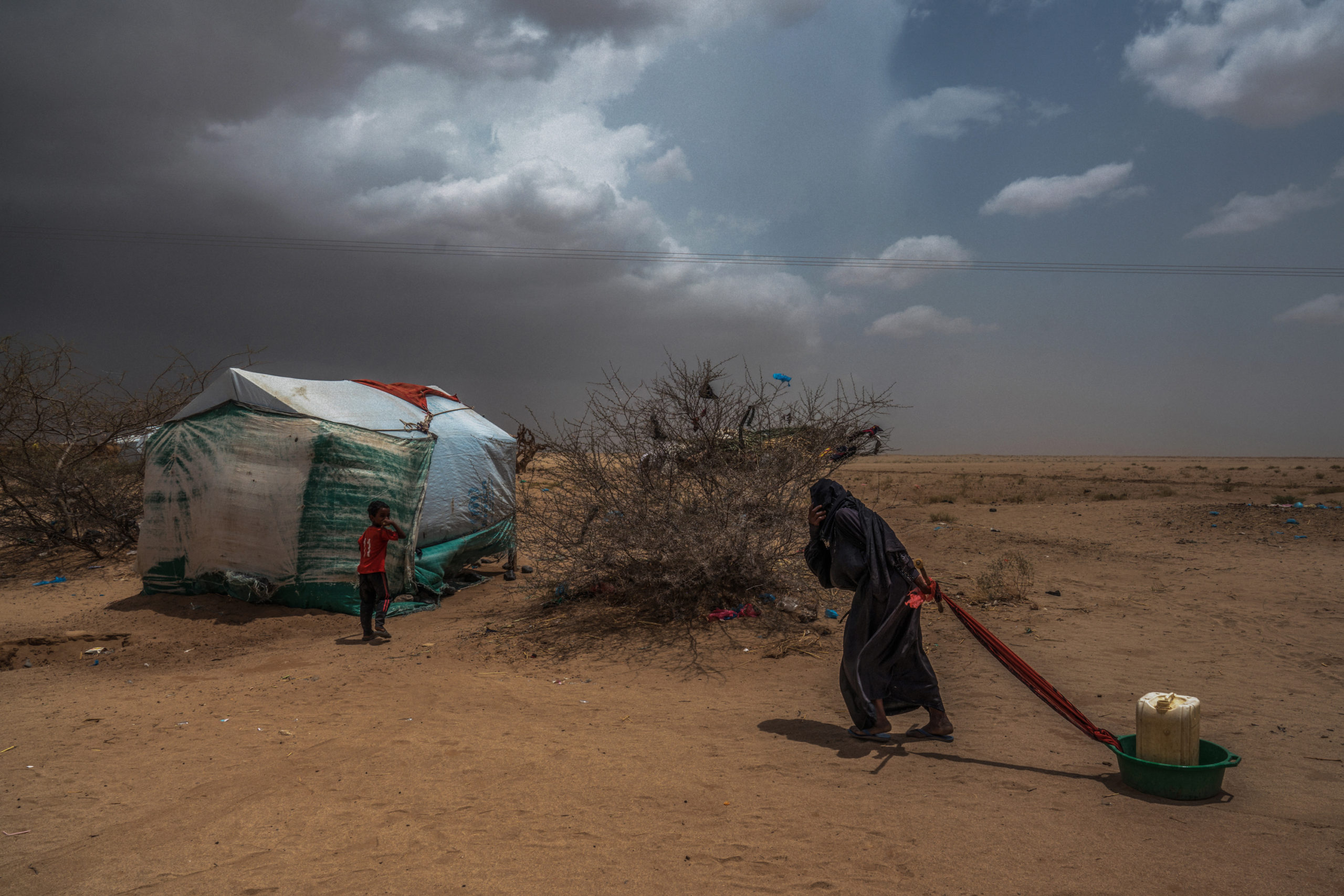
Khasmir Idp Settlement, Khamir, Yemen – 4 May 2017. A displaced woman drags water back to her tent. ©Giles Clarke/WARS Winner 2021
More than 160 photoreporters from over 37 countries have taken part in the second edition of WaRS – War And Revolutionary Stories, the international award created by Associazione 46° Parallelo/Atlante delle Guerre e dei Conflitti del Mondo and Montura, sponsor of the contest, together with the NGO INTERSOS and Fondazione Museo Storico del Trentino.
Two were the categories for this year’s award: one dedicated to COVID-19 stories, and one for conflicts and humanitarian crises. “The reason we added a Covid-19 category” explains Fabio Bucciarelli, photoreporter and artistic director of the competition “is that the pandemic, besides changing our lives, has also changed the way photojournalists conduct their work. Due to the restrictions on travel, many were forced to photograph and redescover their home territory, throwing themselves into potentially very long projects”.
“The winners – Bucciarelli continues – as well as other participants, have submitted long-term projects they had dedicated months to, even years. This is in line with the way we operate, too: taking time to tell stories, to get close to the people, to create empathy. A journalistic practice that, we believe, can be an antidote to fake news”.
The second edition of WaRS saw the participation of photo reporters from all kinds of countries, with proposals which varied greatly from each other. “The winners and the four finalists – Bucciarelli concludes – have submitted very different works, but in general all of the projects were highly eterogeneous: a testimony to how the world of photojournalism is extremely lively and in ferment”.
Categoria: Conflict & Consequences Stories
Primo premio: Giles Clarke with “Yemen; Conflict+Chaos”
Finalista: Finbarr O’Reilly with “TIGRAY CRISIS”
Finalista: Stepanov Anatolii with “War in Ukraine”
Categoria: Covid-19 Stories
Primo premio: Michele Spatari with “No Place Like Hope: the COVID-19 pandemic in South Africa”
Finalista: Rodrigo Abd with “Naked Peru”
Finalista: Yan Boechat with “Death in the Amazon”
It’s all about fragments, precise moments in contexts that have nothing precise in themselves – nothing but the tragedy surrounding the people. This year too, great pictures have won the Montura Photographic Award “WaRS – War and Revolutionary Stories”. That’s what matters to us.
We have wanted and created this Photographic Award – we happily remind ourselves – to add layers to our daily task of narrating the World. Telling stories means creating opportunities: giving everyone a piece of history to reflect upon, a little bit of truth to build an opinion upon. And having an opinion, being able to elaborate ideas, thoughts and views means being free. The type of photography we support aims to do this: help make everyone a little more free, by explaining what happens in the tragedy of wars, or in the dramatic context of a life-changing pandemic. It gives us the exact measure of what millions of people are going through in this exact moment. It reveals injustices, poverty, the systemic violations of rights that daily crushes peoples and individuals.
The two winners, Giles Clark, with “Yemen; Conflict+Chaos” and Michele Spatari with “No Place Like Hope: the COVID-19 Pandemic in South Africa”, did exactly this. This is why we are grateful for their work: because they, as well as the many, many others who participated in this second edition of the award, connect us to pieces of reality: they have grasped them, turned them to images, snapshots of truth. They have fixed these truths in a collective memory that will be available to everyone, to anyone. In doing so, in giving us knowledge and conscience, they have freed us all.
Raffaele Crocco / Director Atlas of war and conflicts
Looking at the Covid-19 entries as a member of the jury of Wars 2021. 67 projects from all over the world. Gaza, India, Spain, Brazil, Italy, Peru, Africa….I wanted to keep an open mind on such a coverage after being overwhelmed for the past two years by photos : the masks, the covid’s units in hospitals, the mass graves, the scare, the coffins, the nurses in full gears, the loneliness. Did I see it all? What would impress me? The originality? Some projects tried but in my view they tried too much and failed. A narrow focus on an aspect of the pandemic? It was not satisfying with the danger of aestheticism. In the final round, we had 7 projects which were all relevant because they all showed a form of reality with honesty, emotion, visual impact. I choose (and the jury) Michele Spatari’ reporting in South Africa because of its scope, showing the effects of Covid in the streets, in the home. Also his photos made me feel the anguish, the violence, the desperation and the sense of how different it is to experience Covid depending where you are on earth, South Africa or France where I was.
Francis Kohn / Former AFP Director WARS 2021 Jury
“Pulling back the curtain” is a phrase often used in defining the mission of photojournalists. This year, we jurors were privileged to be presented with outstanding work from around the world that did just that. In the end, and by happenstance, we chose three underreported crises for the top spots. Over the past several years, the conflict in Yemen has forced millions of civilians to flee their homes and negotiate their existence facing tribal divisions, famine and a shattered infrastructure. Giles Clarke’s powerful work from the region gives us a poignant look at their new, tragic normal as well as their resilience in navigating this humanitarian crisis. Until recently, the war in Ukraine had largely left the headlines in the past few years, but the fighting continued. Anatolii Stepano’s work captures the tension in the daunting landscape and takes us down into the eerie bunkers on the frontlines in the Donetsk region where Ukrainian fighters face an uncertain fate against the aggression of Russian-backed separatists. Due to the outbreak of COVID-19, the war in Ethiopia’s Tigray region has stayed largely under the international radar. But the level of widespread massacres, sexual assault and ethnic cleansing evokes memories of the tragedy in Rwanda in 1994. Finbarr O’Reilly’s haunting images from Tigray capture the essence of these atrocities in a war that is just over a year old. With great appreciation for the important work by all the entrants, we congratulate Giles for his extraordinary award-winning submission, along with our finalists, Anatolii and Finbarr. Because of your passion and determination — in the words of the late, great Yannis Behrakis — the world can’t say “I didn’t know.”
Kelli Grant / Photo Director Yahoo News WARS 2021 Jury
Categoria: Conflict & Consequences Stories
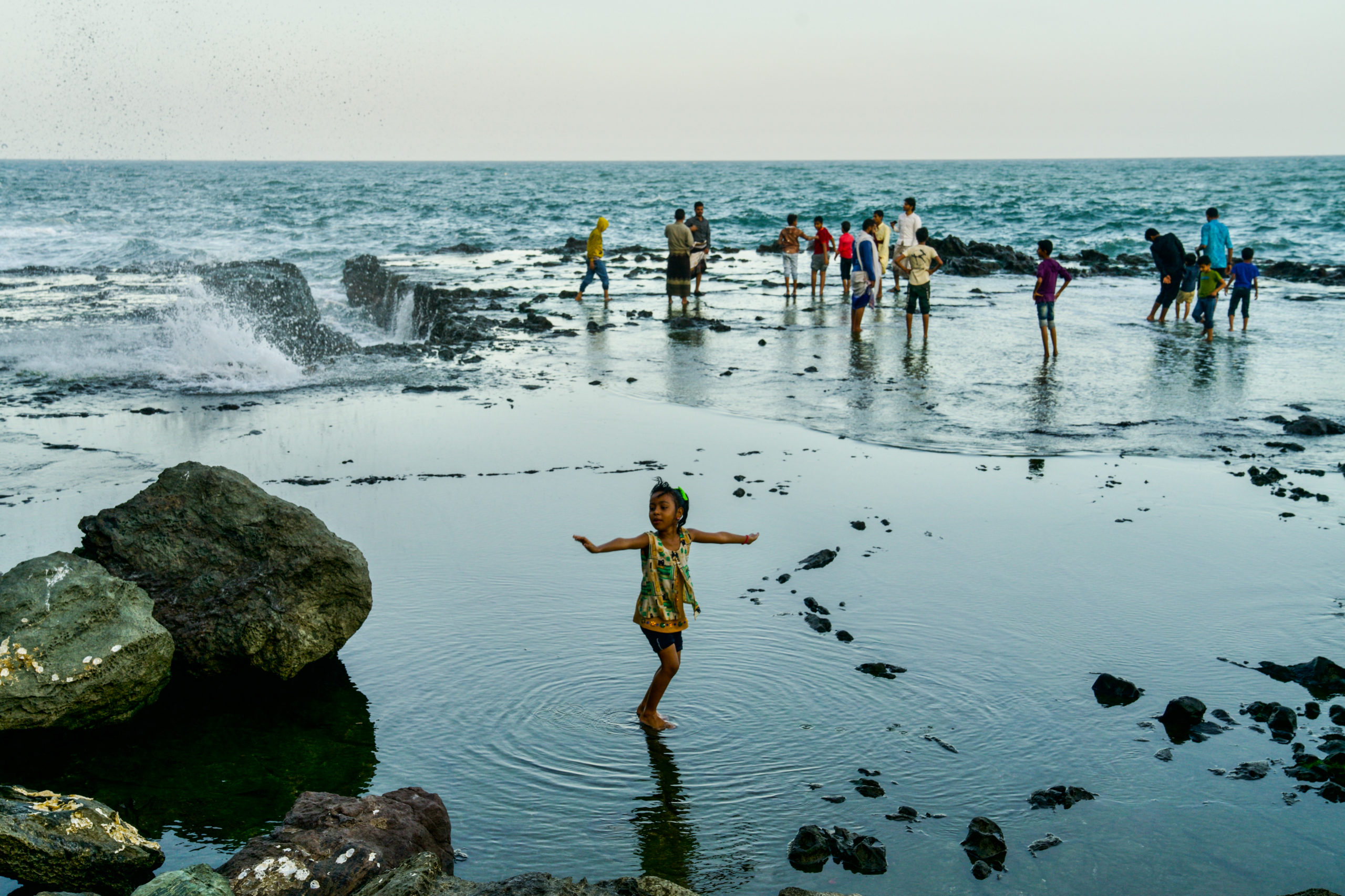
Serra, Aden, Yemen. March 2019. A little girl plays in the water as waves hit the shore at Serra beach located near Aden in south Yemen. A rare scene of joy in a country decimated by war since 2015.
Giles Clarke – Yemen; Conflict+Chaos
Category: photo stories related with conflicts and their consequences.
1st Prize Winner
PROJECT DESCRIPTION
In March of 2015, a coalition led by Saudi Arabia and supported by Western governments including the US, France and the UK began a heavy and prolonged air bombing campaign against Yemen. According to the UN, the war has killed at least two hundred and thirty thousand people. Much of the country’s already weak infrastructure is now destroyed. The multi-national military intervention came after Houthi rebels forces removed the internationally recognized government in late 2014. As the war progressed, the Houthis rebels, who have long been allied with Iran, seized control of vast areas of the country. From 2015 until the present day, the war has been fought on many shifting fronts from Al Hodeidah on the Red Sea coast to the now-divided city of Taiz. In 2020, the fighting flared in the desert region of Ma’rib as the Houthis pushed toward the country’s oil fields. The UN Refugee Agency estimates that almost four million people have had to flee their homes due to conflict with many now living in scattered internally displaced person (IDP) settlements. From early 2016, the Saudi-led coalition has imposed an ongoing blockade of critical imports into Red Sea ports that serve much of northern Yemen, and food is often prohibitively expensive due to complications associated with port restrictions. With ever-shifting frontlines between the Yemeni government and Houthi forces as well as the presence of Al Qaeda and other militant groups (ISIS) in Yemen today, the widespread fighting has severely obstructed humanitarian aid distribution with the now-deadly threat of famine looking likely in the more rural areas of north west Yemen. ‘Yemen : Conflict+Chaos’ portrays a country fractured by war and tribal division; a place where the civilian population exists chained to an eternal struggle and trapped in a haunted present.
AUTHOR BIOGRAPHY
Giles Clarke is a photojournalist based in New York City and focusing on capturing the human face of current and post-conflict issues throughout the world. Clarke began his photography career as a professional black and white printer in London and New York. During the mid 1990’s, he worked in the Richard Avedon darkroom in New York on now-iconic fashion campaigns. Since 2016, Clarke has been working on raising awareness on the plight of those living in war-torn Yemen and the troubled Sahel region of Africa. Clarke’s work has been featured by The United Nations (OCHA), The New York Times, Amnesty International, CNN, The Guardian, Global Witness, TIME, The New Yorker, National Press Photographers Association, Paris Match et al. For his work in Yemen, Clarke was awarded a coveted Lucie statue in 2017 and was named the ‘Imagely Fund Fellow’ of 2018. In August 2021, Clarke exhibited a solo show ‘Yemen; Conflict+Chaos’ at Visa Pour L’Image in Perpignan, France.
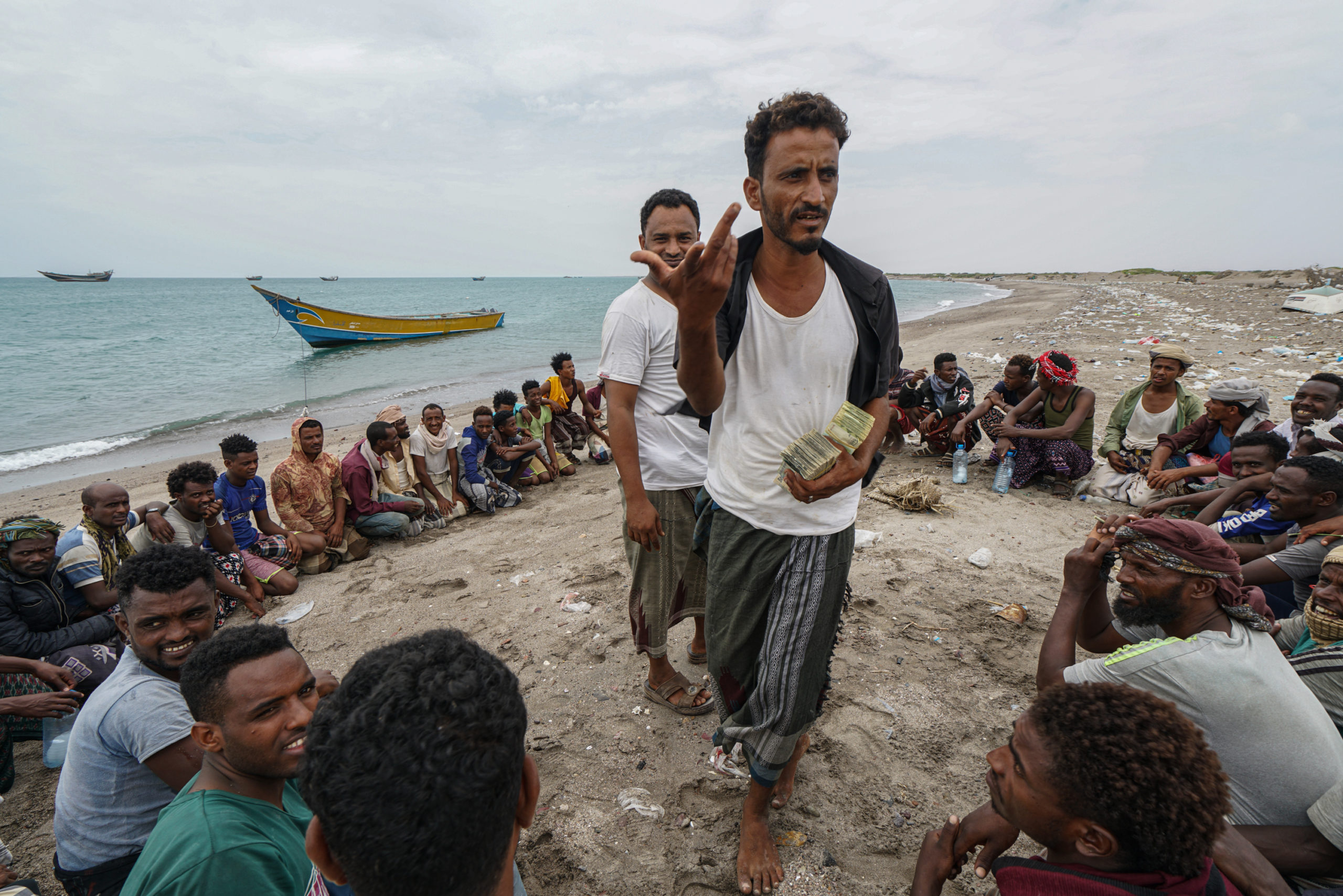
Ras Al-Ara beach, Lahj, Yemen. November 25, 2020.
On a smugglers beach some 150km west of Aden, an animated paymaster prepares to pay cash to local and migrant workers who are employed as casual labor. This remote beach has become the gateway for thousands of arriving migrants and refugees into Yemen – most of whom arrive in the early morning after leaving the north African coast the night before.
Photo by Giles Clarke for UN/OCHA

Khamir Idp Settlement, Khamir, Yemen – 4 May 2017. A displaced woman drags water back to her tent.
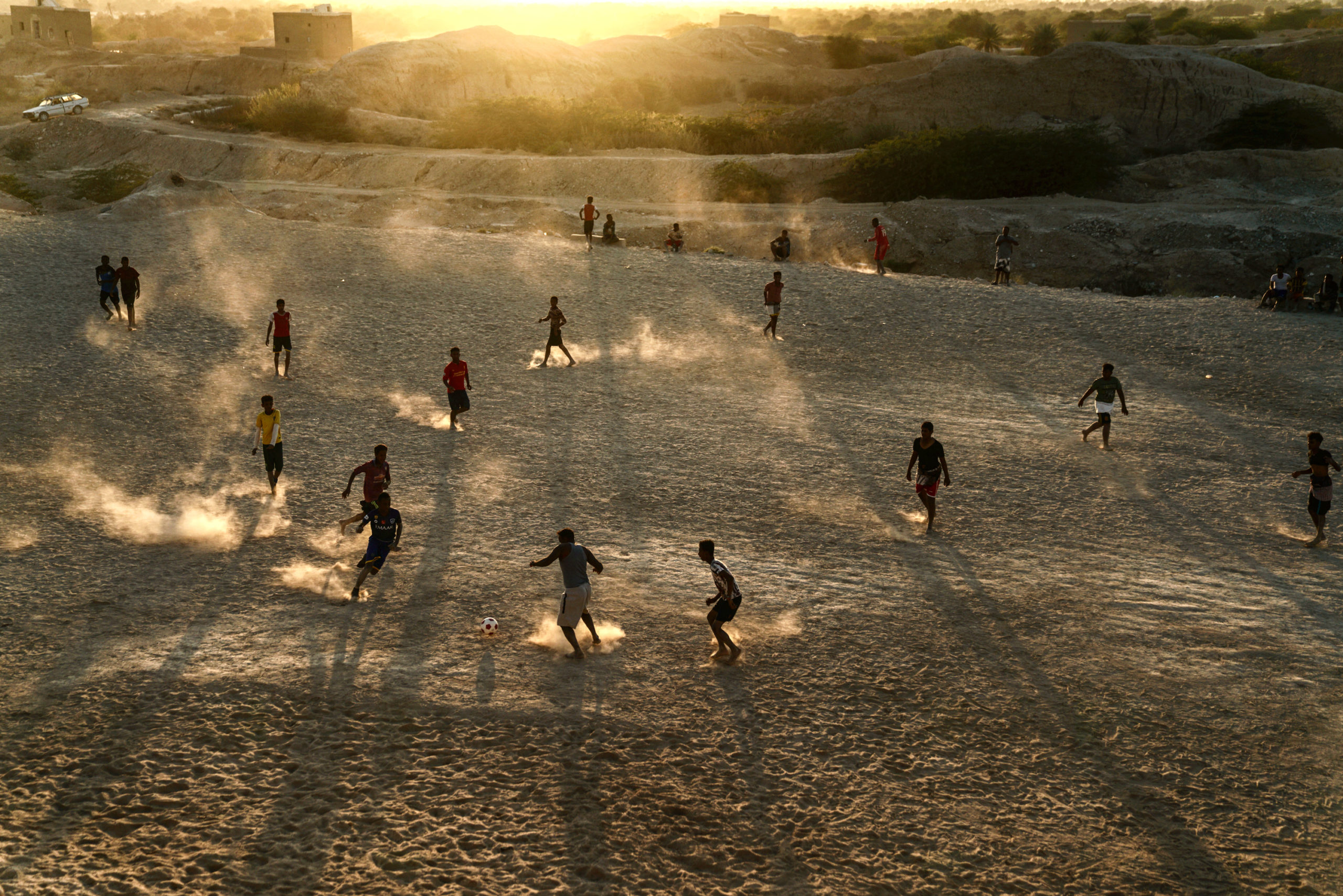
Shibam, Hadramout, Yemen. December 2020. Football in the shadows of Shibam.
Photo by Giles Clarke for UN/OCHA
[ngg src=”galleries” ids=”1″ display=”basic_thumbnail” thumbnail_width=”390″]
Finbarr O’Reilly – Tigray Crisis
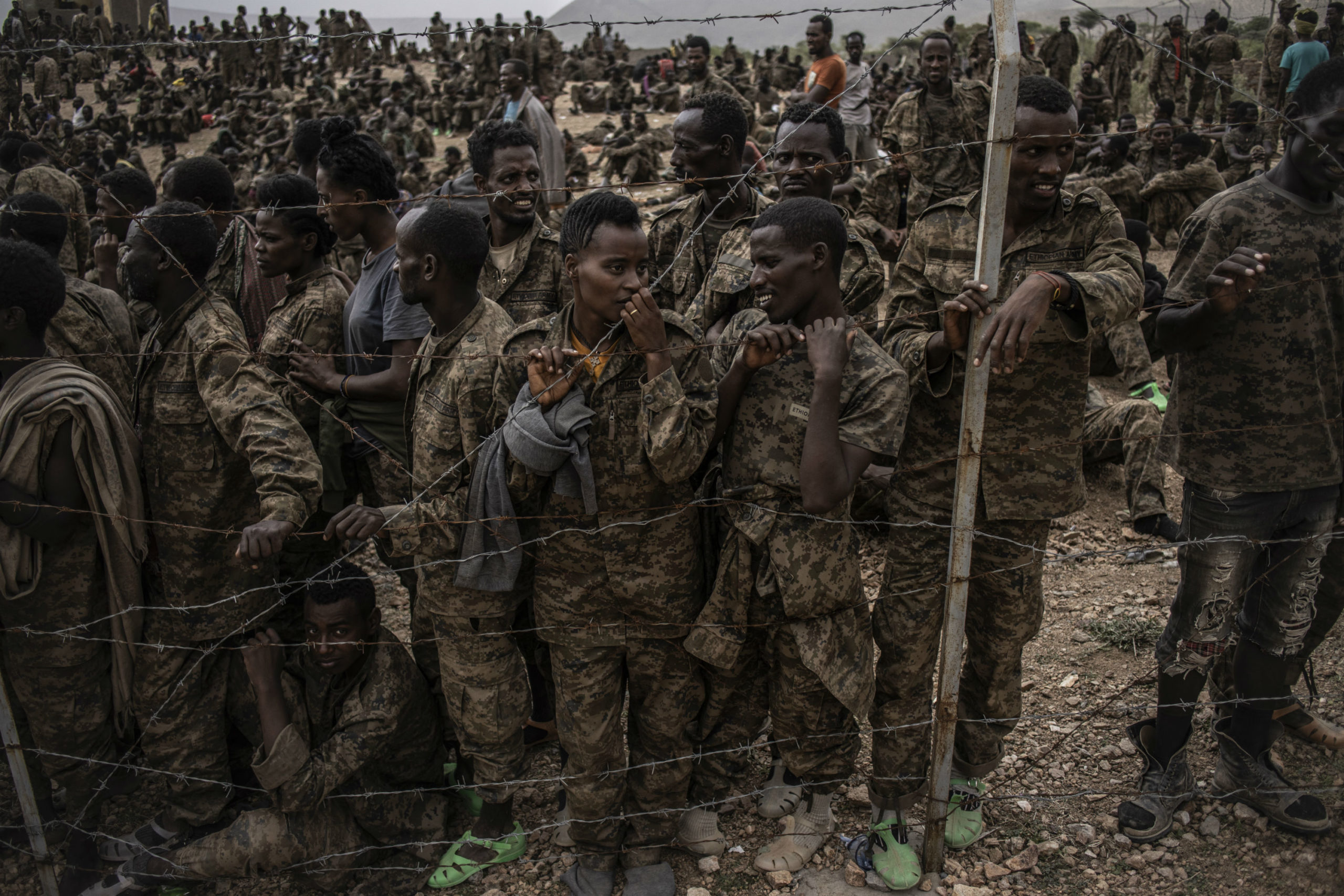
Ethiopian National Defense Forces soldiers are held at a camp for an estimated 3,000 prisoners of war after being captured last week by Tigray Defense Force rebels during fighting south of the city of Mekelle in Ethiopia’s northern Tigray region on June 23, 2021. Finbarr O’Reilly for the New York Times
Category: Photo Stories related with conflicts.
Finalist
PROJECT DESCRIPTION
The war in Ethiopia’s northern Tigray region has been marked by atrocities and starvation. Fighting erupted in November 2020, when a simmering feud between prime minister Abiy Ahmed and Tigrayan leaders, members of a small ethnic minority who had dominated Ethiopia for much of the three previous decades, exploded into violence. Since then, fighting has been largely hidden from view, obscured by communications blackouts, and overshadowed by international outrage over an escalating humanitarian crisis. But during a pivotal week, I went behind the front lines on assignment for The New York Times and witnessed a cascade of Tigrayan victories that culminated in their retaking the region’s capital and altered the course of the war. Abiy’s forces and his Eritrean allies have been accused of widespread massacres, sexual assault, and ethnic cleansing. The UN and aid organizations said that while 5 million people in Tigray urgently need help, Ethiopian officials are using harassment and obstruction to restrict the flow of aid into the region. Trucks filled with food, medicine, and fuel are stranded in a neighboring region, denied permission to move. Since retreating from Tigray in June, Ethiopia’s government has closed Tigray’s banks, blocked fuel supplies, and shut down phone lines and Internet access, creating a humanitarian blockade. Ethiopia recently ordered the expulsion of 7 senior UN officials overseeing aid operations to Tigray, where 23 humanitarians have been killed during the war. If carried out, the order would be the biggest expulsion of senior UN humanitarian officials from any country, adding to previous expulsions of aid workers from Doctors Without Borders and the Norwegian Refugee Council. Abiy, who won the 2019 Nobel Peace Prize, has reacted to mounting international pressure with anger and defiance. These images were taken during a week of fast-moving breaking news as Tigrayan forces gained the upper hand in a devastating war that seems far from over.
AUTHOR BIOGRAPHY
Finbarr O’Reilly is an independent photographer and multimedia journalist, and the author of the nonfiction memoir, Shooting Ghosts, A U.S. Marine, a Combat Photographer, and Their Journey Back from War (Penguin Random House 2017). Finbarr lived for 12 years in West and Central Africa and has spent two decades covering conflicts in Congo, Chad, Sudan, Afghanistan, Libya, and Gaza. He is the 2019 Nobel Peace Prize exhibition photographer and a frequent contributor to The New York Times. His photography and multimedia work has earned numerous industry honors, including First Place in the Portraits category at the 2019 World Press Photo Awards. He was also winner of the World Press Photo of the Year in 2006 and earned a 2020 Emmy for the PBS Frontline documentary Ebola in Congo. Finbarr is a Canon Ambassador.
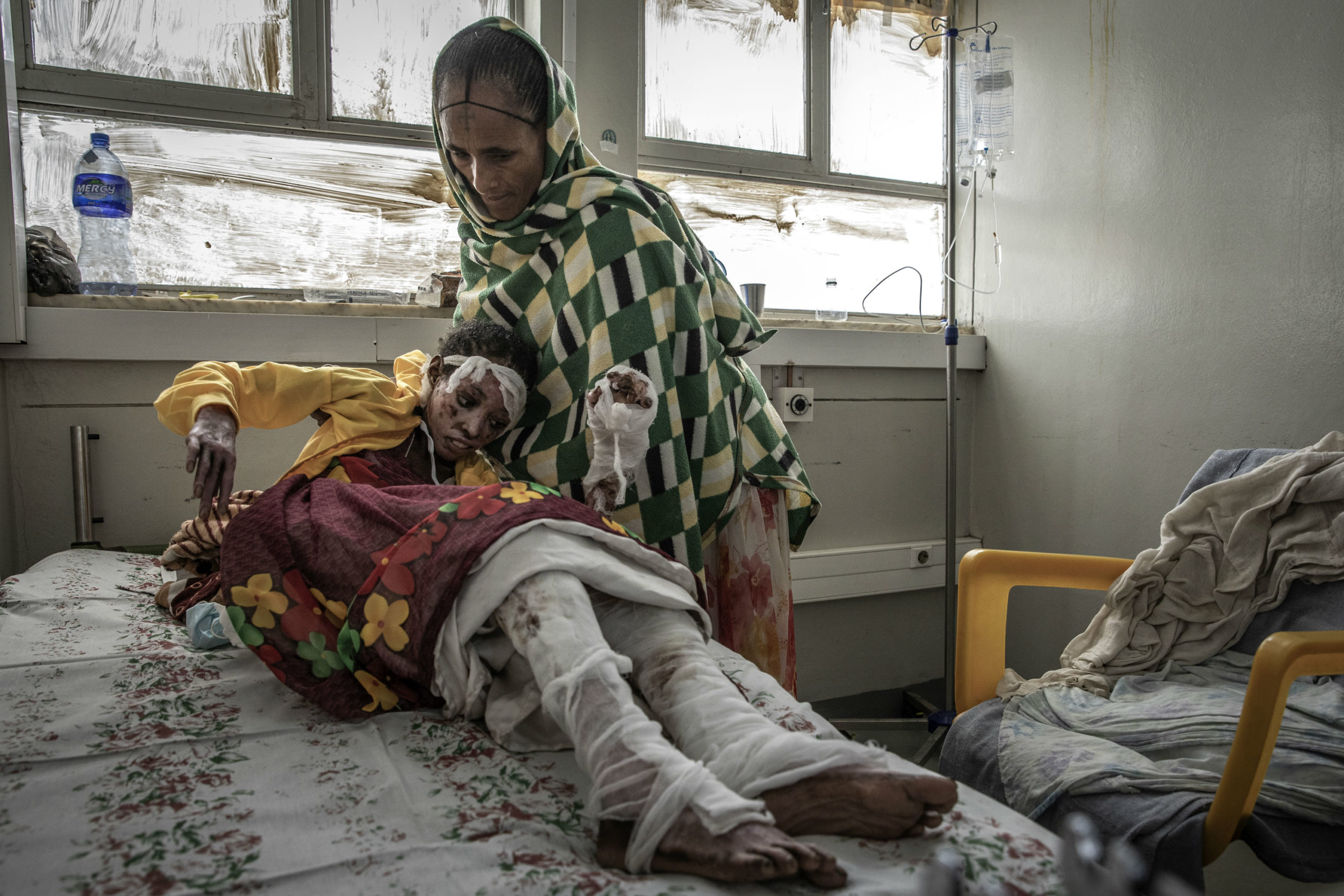
Genet Asmelash, 40, lifts her daughter Kesanet Gebremichael, 13, onto a bed at the Ayder hospital in the city of Mekelle in Ethiopia’s northern Tigray region on June 25, 2021. Kesanet suffered burns to her face, arms, and legs when an explosive devise hit her home on April 20th in the town of Feresmay, 30 miles east of the city of Adwa in the Tigray region. Finbarr O’Reilly for the New York Times
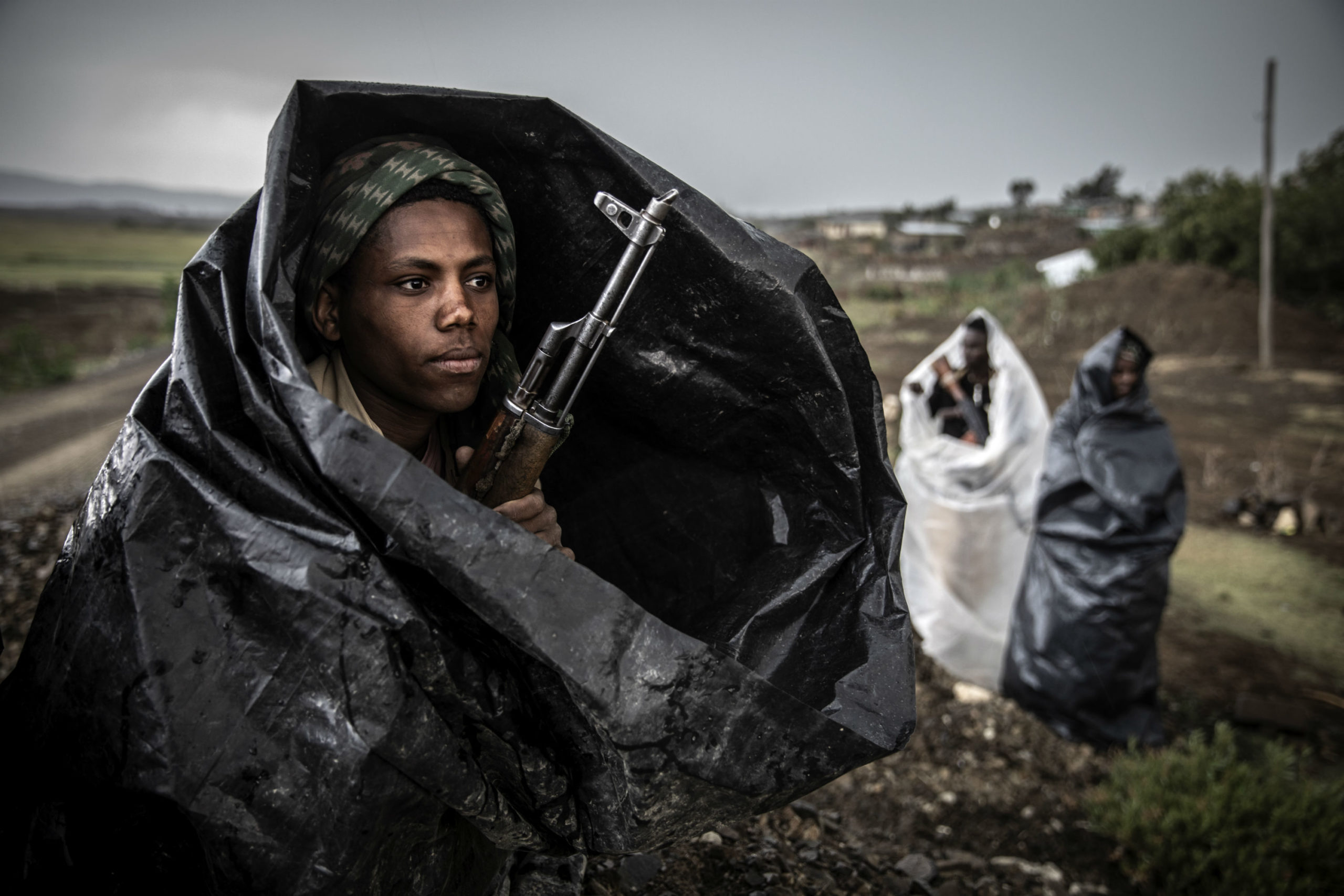
A fighter from the Tigray Defence Forces uses a plastic bag to shelter from a hail storm while guarding a camp holding hundreds of Ethiopian army prisoners of war in the mountains southwest of the regional capital Mekelle in Ethiopia’s northern Tigray region, on June 29, 2021. Finbarr O’Reilly for the New York Times
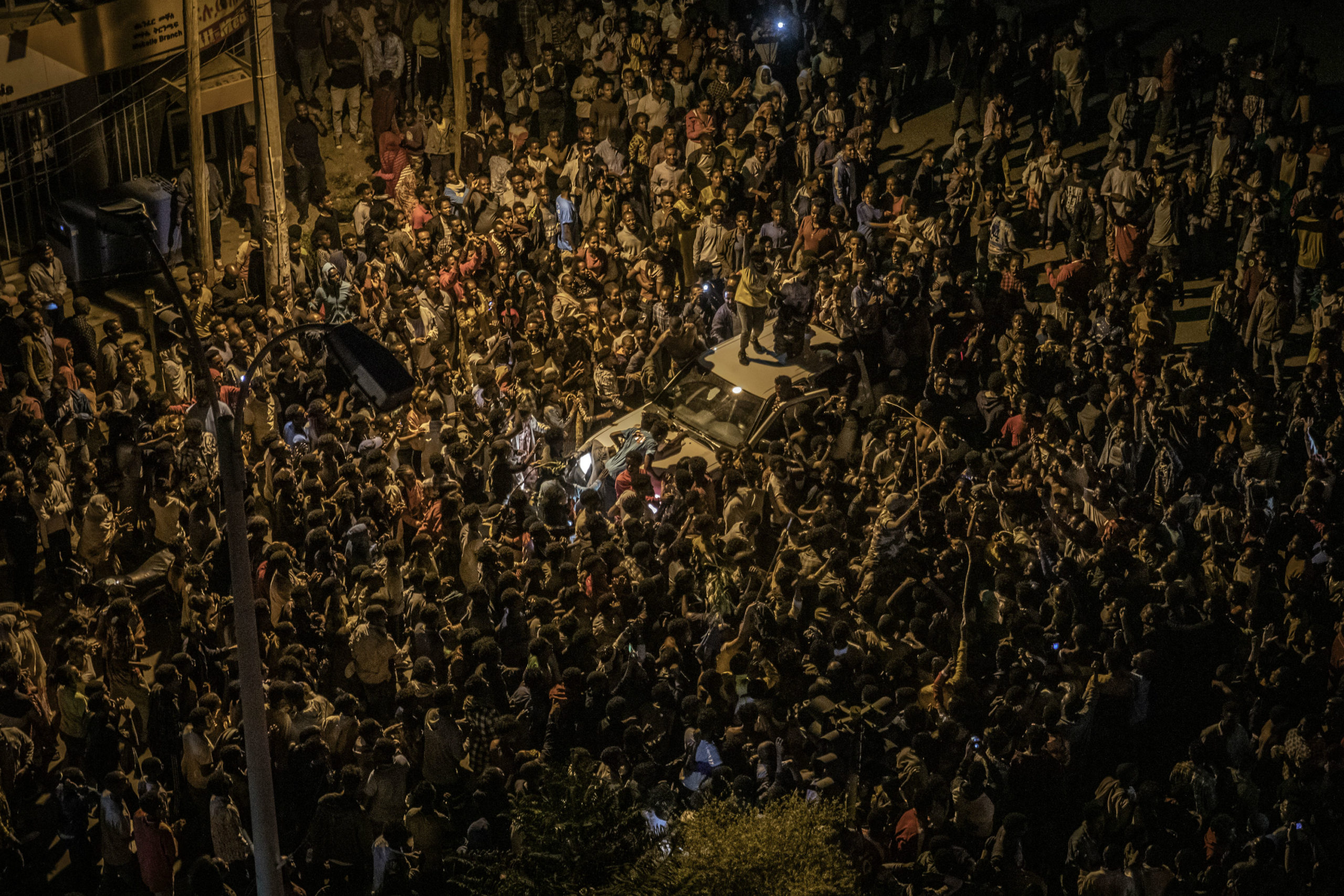
Crowds gather to celebrate the departure of Ethiopian government forces and the arrival of the rebel Tigray Defence Forces in the city of Mekelle in Ethiopia’s northern Tigray region on June 28, 2021. Finbarr O’Reilly for the New York Times
[ngg src=”galleries” ids=”2″ display=”basic_thumbnail” thumbnail_width=”390″]
Stepanov Anatolii – War in Ukraine
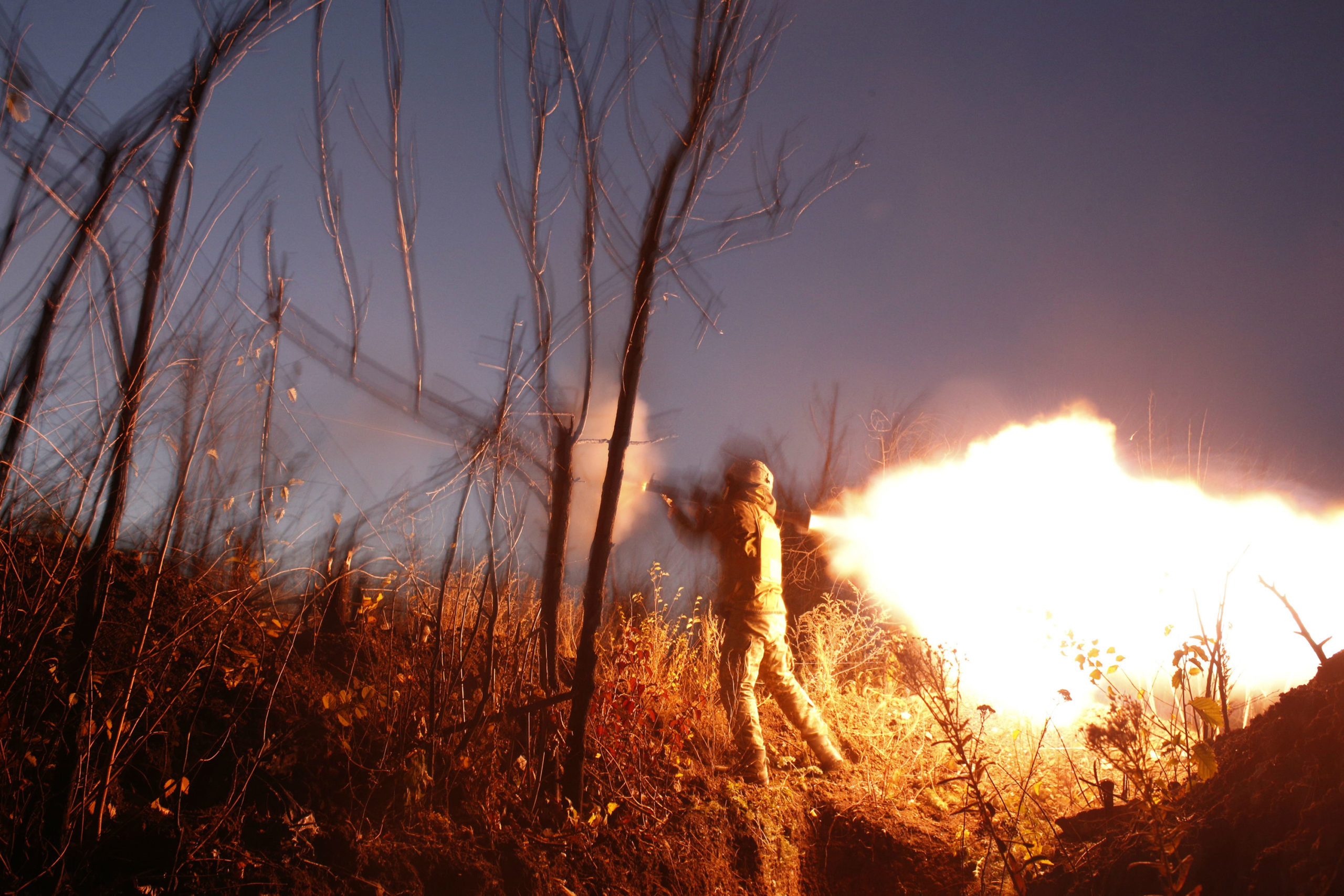
Ukrainian serviceman Illya 19 y.o. fires the anti-tank grenade launcher during a night battle against Russia-backed separatists at the Butovka coal mine near the Avdiivka town, Donetsk region, 03 November 2018.
Category: Photo Stories related with Conflicts
Finalist
PROJECT DESCRIPTION
War in Ukraine The war in Ukraine is no longer in the news lines. Even in 100 km away from the frontline almost nothing reminds of it. Days in trenches are dragging on. But this boredom is deceptive. Any instant a sniper can strike you… as night time approaches mortars are waking up. Sometimes heavy artillery works. Shootings start. Euronews, BBC or CNN will tell nothing about it but it collects its deadly harvest every week on both sides of the frontline.
AUTHOR BIOGRAPHY
Stepanov Anatolii, Kyiv, Ukraine. In 1994 received a specialist degree as electronics engineer from Kyiv Polytechnics, worked as engineer and at the managerial positions at various companies. In 2004 has completed a Photography School of Victor Marushchenko. Since then worked in the sphere of professional photography both as a freelancer and a staff photographer. Cooperates with the agencies AP, Reuters, AFP, EPA, Sipa; had publications in the journals: National Geographic, Spiegel, Stern, Time and etc. Participated in collective photo exhibitions in Ukraine, Germany, France, USA
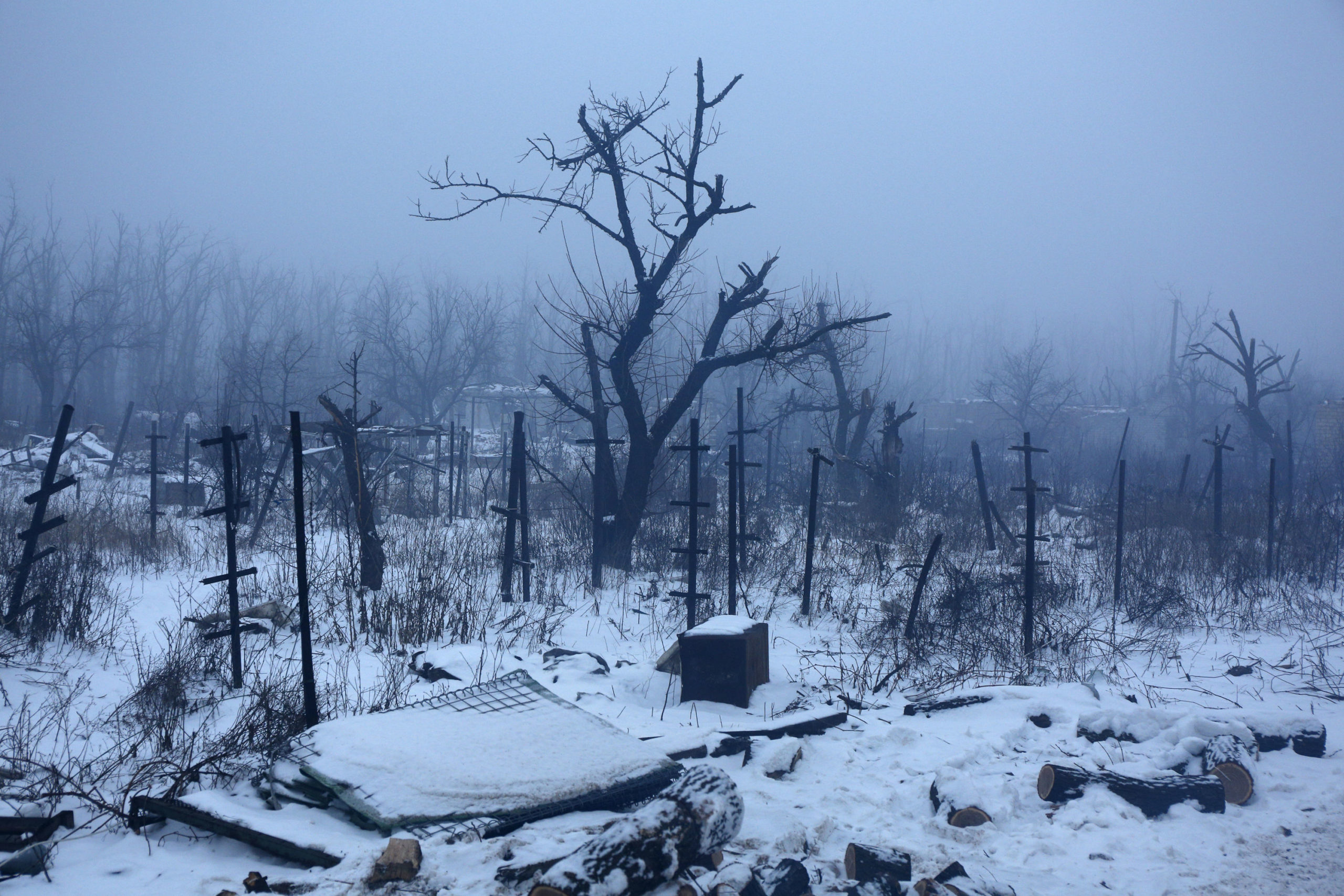
Ukrainian troops’ frontline positions at vineyards near Avdiivka, Donetsk region, 20 Jan 2018.
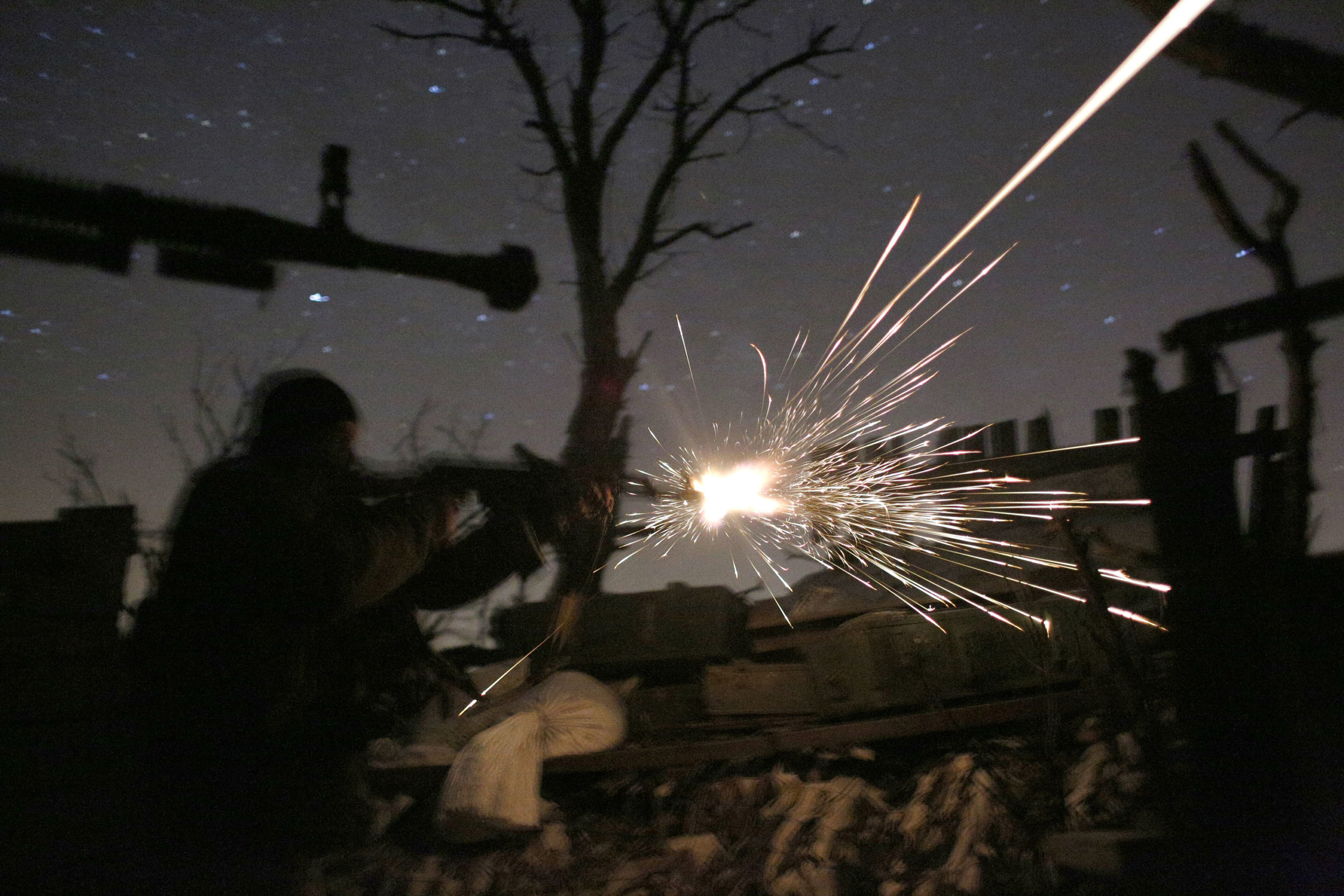
Ukrainian serviceman fires a machine gun during a night battle with Russia-backed separatists in the industrial zone on the outskirts of Avdiivka, Donetsk region, Ukraine, March 31, 2017. One of the features of the war in eastern Ukraine is the intensification of battles every night.
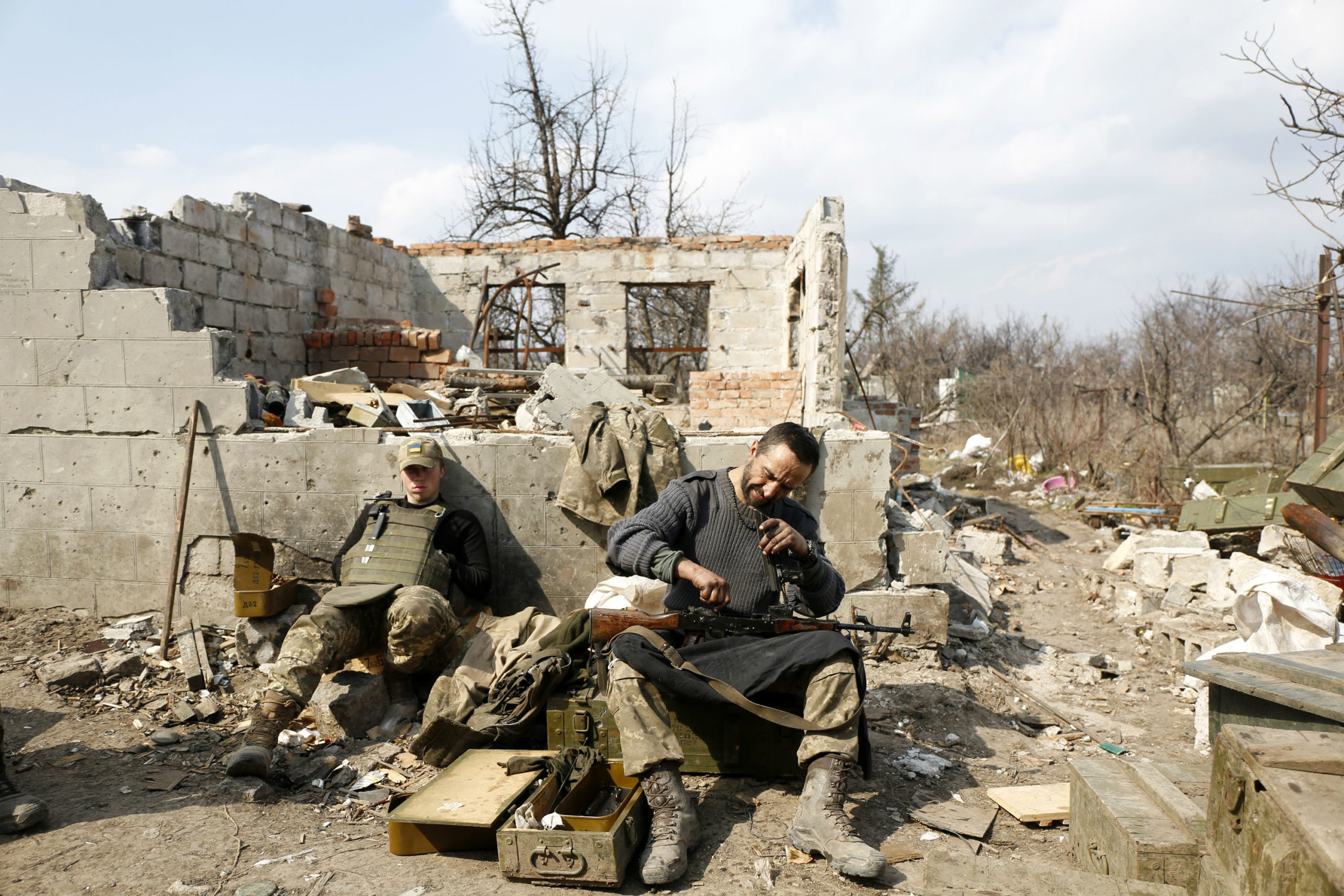
Ukrainian servicemen Max, 18 y.o., and Sergiy, 42 y.o., get some rest and prepare ammunition during a break between battles with the Russia-backed separatists in the frontline position in the industrial zone on the outskirts of Avdiivka, Donetsk region, Ukraine, March 30, 2017. Sergiy was killed on April 25.
[ngg src=”galleries” ids=”3″ display=”basic_thumbnail” thumbnail_width=”390″]
Categoria: Covid-19 Stories
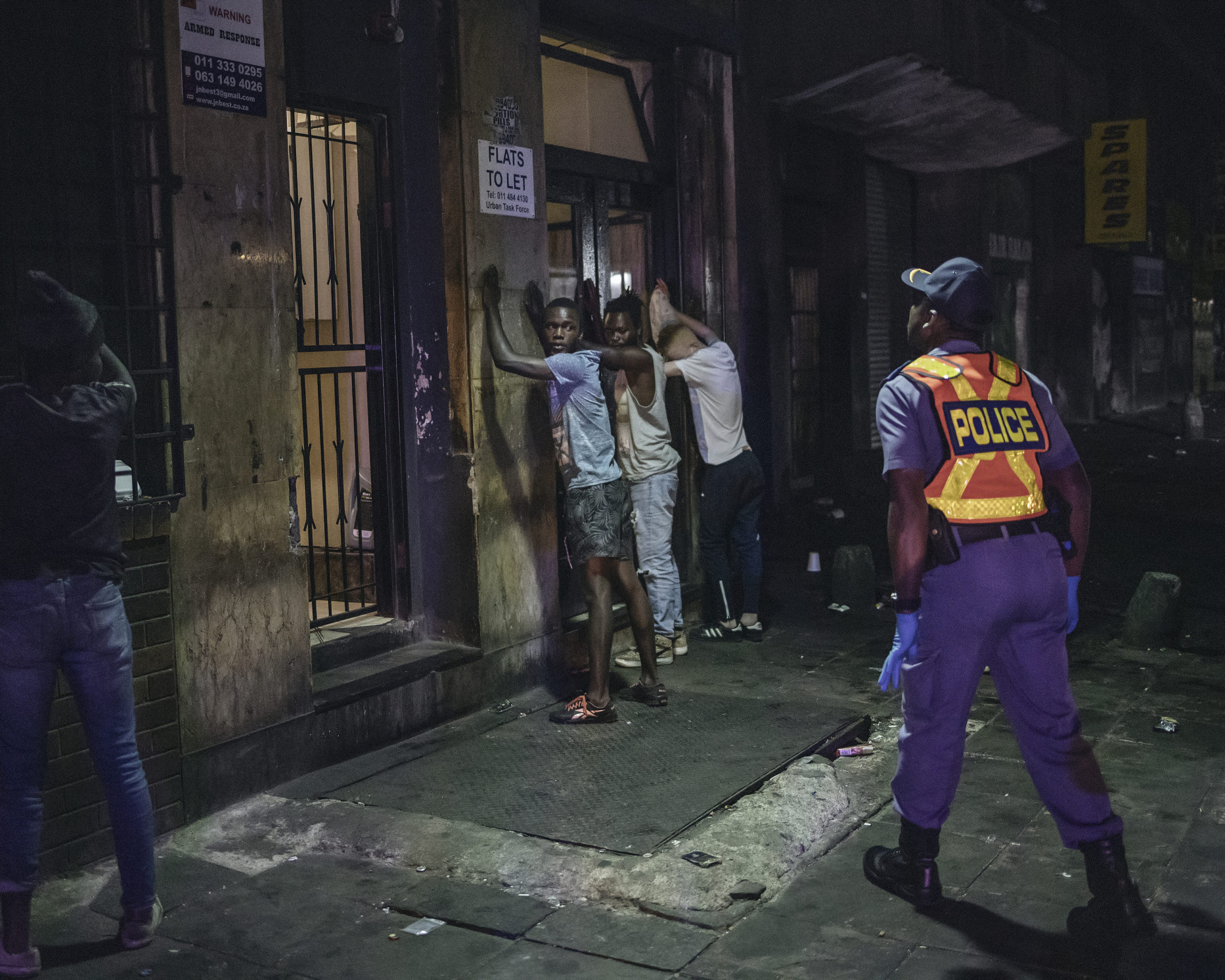
A member of the South African Police Service (SAPS) screams at men lined up against a wall to have defied the lockdown rules in Johannesburg Central Business District, South Africa, on March 27, 2020. During a joint patrol of South African Police Service (SAPS) and Johannesburg Metro Police Department (JMPD) members found the men sleeping in a battered car on the side of a road an hour after the stay-at-home order became law and proceeded to detain them. To prevent the spreading of the COVID-19 coronavirus outbreak, authorities put the country on an early lockdown at the end of March 2020. The South African Police and Army – called to enforce the new emergency rules – have been accused of gruelling and humiliating punishments to enforce quarantine on the most vulnerable groups, with three civilian deaths allegedly at the hands of law enforcement on the first weekend only.
Michele Spatari – No Place Like Hope: the COVID-19 pandemic in South Africa
Category: Covid-19 Photo Stories
1st Prize Winner
It went from the surprise that sprung from a distant observation to a disillusioned denial; it became slowly part of a new normal, and finally hit the mark with the power of surging numbers and the inevitable toll of deaths. The pandemic reached South Africa: its coming has blurred racial and economic divides and puts strain to deep running fault lines, contradictions etched into its people consciousness. At the beginning of March 2020, South Africa discovered that Patient Zero was among its population, and a scramble to contain the panic was finally met by an inevitable lockdown. Deserted streets, panic buying and curfew. The humming of the South African Army patrol vehicles and the familiar blue lights of the police filled the streets of Johannesburg. From deep into their recessed dwellings and into the overcrowded buildings and the shacks of the informal settlements, residents learned the reverse irony of “physical distancing”: a defiance to the law of physics, a surreal reality for those to whom the simple notion of “space” sounds unmeasurable. The lockdown has been imposed with sticks and whips, rubber bullets shot at close range, during night raids where residents have been woken from their provisional beds in overcrowded rooms. Life at the margins of society has been reduced to a matter of square meter occupancy. South Africa followed the climbing numbers peeking over the shoulders and making peace with a new reality: the people, its most vulnerable people, was starving. The lockdown left a stranded economy already on its knees: the hand-to-mouth feeding scheme revealed its limits and its failure. As kilometers long lines have recalled in the memory of South Africans the queues that marked the passage from the horror of Apartheid into the new democracy, the livelihood of thousands of families is now on the line. A food line. Stay at home, they said. In South Africa it’s a thread that pulls memories from the past. Apartheid, dispossession, segregation.
AUTHOR BIOGRAPHY
Michele Spatari is a documentary photographer based in Johannesburg. His documentary practice has been influenced by his architectural background and he is now focused on the study of bodies and space: how politics, religions and social rituals shape contemporary societies. His long-term project Rising Water about public showers and housing crisis in Turin won the 2018 Canon Italy Young Photographer Award – Multimedia and has been exhibited at Cortona On The Move Festival, Geopolis – Centre du Photojournalisme, Lumix Festival and Galerie f 3, among others. In 2019 he has been selected by Canon Europe as the Italian representative in Visions from Europe, an artistic residency for Matera European Capital of Culture 2019. In 2020 Michele has been assigned by Cortona On The Move Festival to document the Covid-19 pandemic in South Africa. In 2021 Michele has been chosen as one of the few under 30 to join the Canon EMEA Ambassador Program. Since 2019, he is one of the main contributors in Southern Africa for AFP – Agence France-Presse. His work has been featured on various international media outlets such as The New York Times, The Washington Post, TIME, Le Monde, Libération, The Guardian, The Wall Street Journal, El País, Internazionale, amidst others.
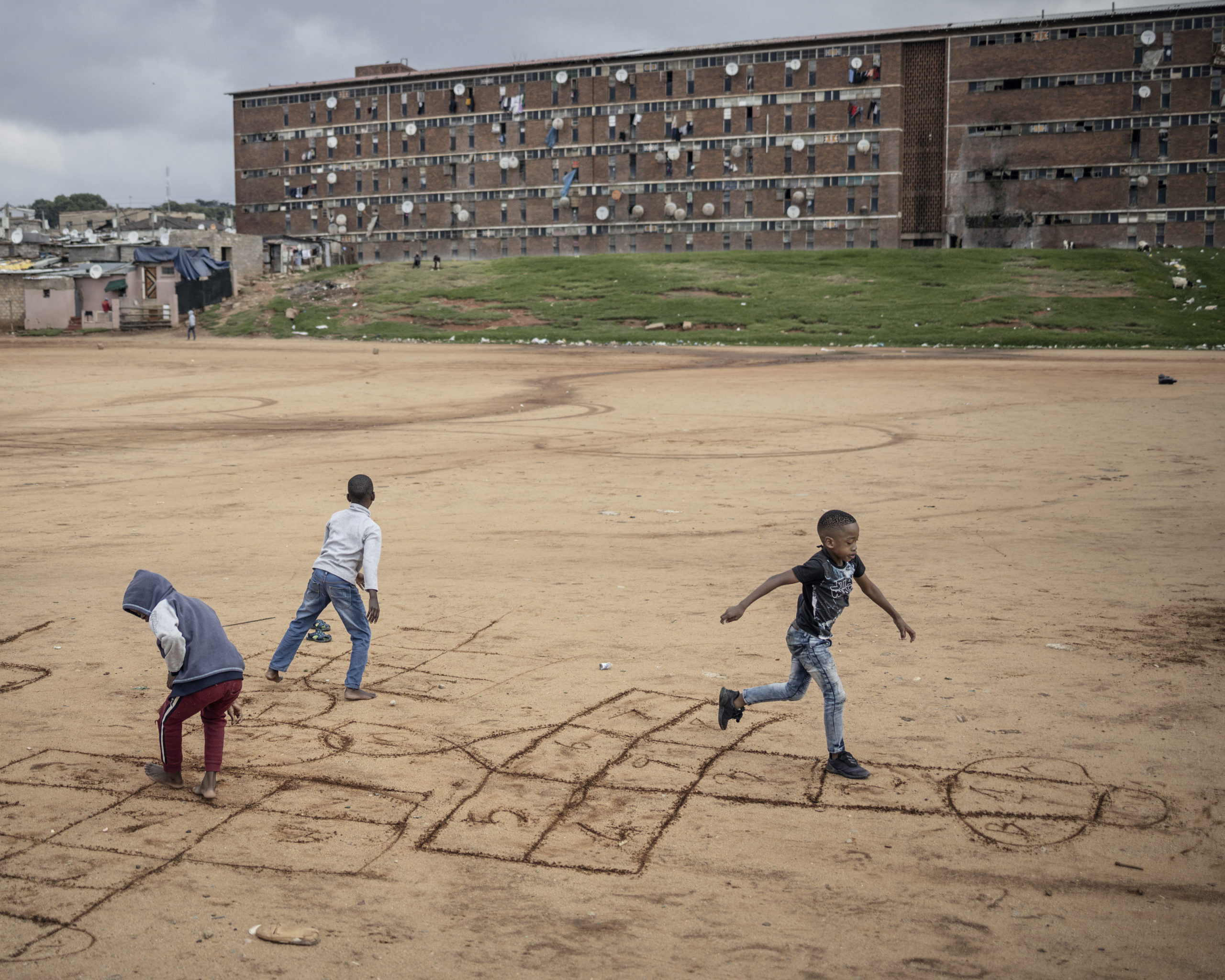
Children play during a COVID-19 coronavirus screening and testing drive in front of the Madala Hostel in Alexandra township, Johannesburg, South Africa, on April 27, 2020.
South Africa has become the epicentre of the COVID-19 coronavirus pandemic in Africa despite enforcing one of the strictest lockdowns in the world, as the pandemic exacerbated deep economic inequalities and weakened a feeble governance.
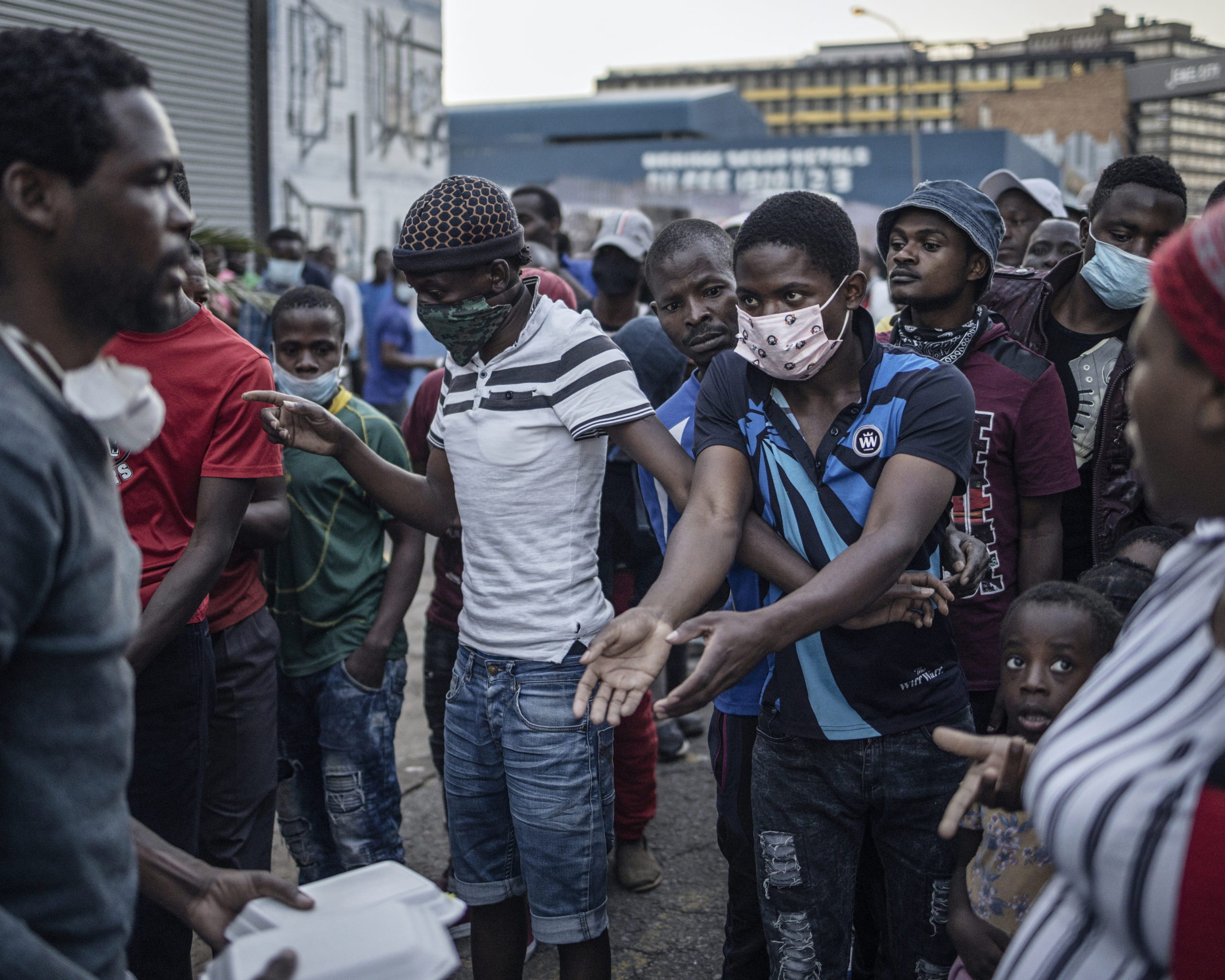
A man queues for a food portion package during a meal distribution organised by a local organisation in the Kwa Mai Mai area of the Johannesburg Central Business District, South Africa, on May 4, 2020. Over 50 people, mostly migrants from neighbouring countries and residents of the same building in Phillips street, found themselves unemployed and stranded with no food in overcrowded boarded-up rooms because of the lockdown imposed by the South African authorities. With the lockdown extended, an already stranded economy has been put on its knees: the hand-to-mouth feeding scheme that has most of the men and women leaving the inner city and the townships looking for wages that would feed their families revealed its bare teeth, its limits and its failure.
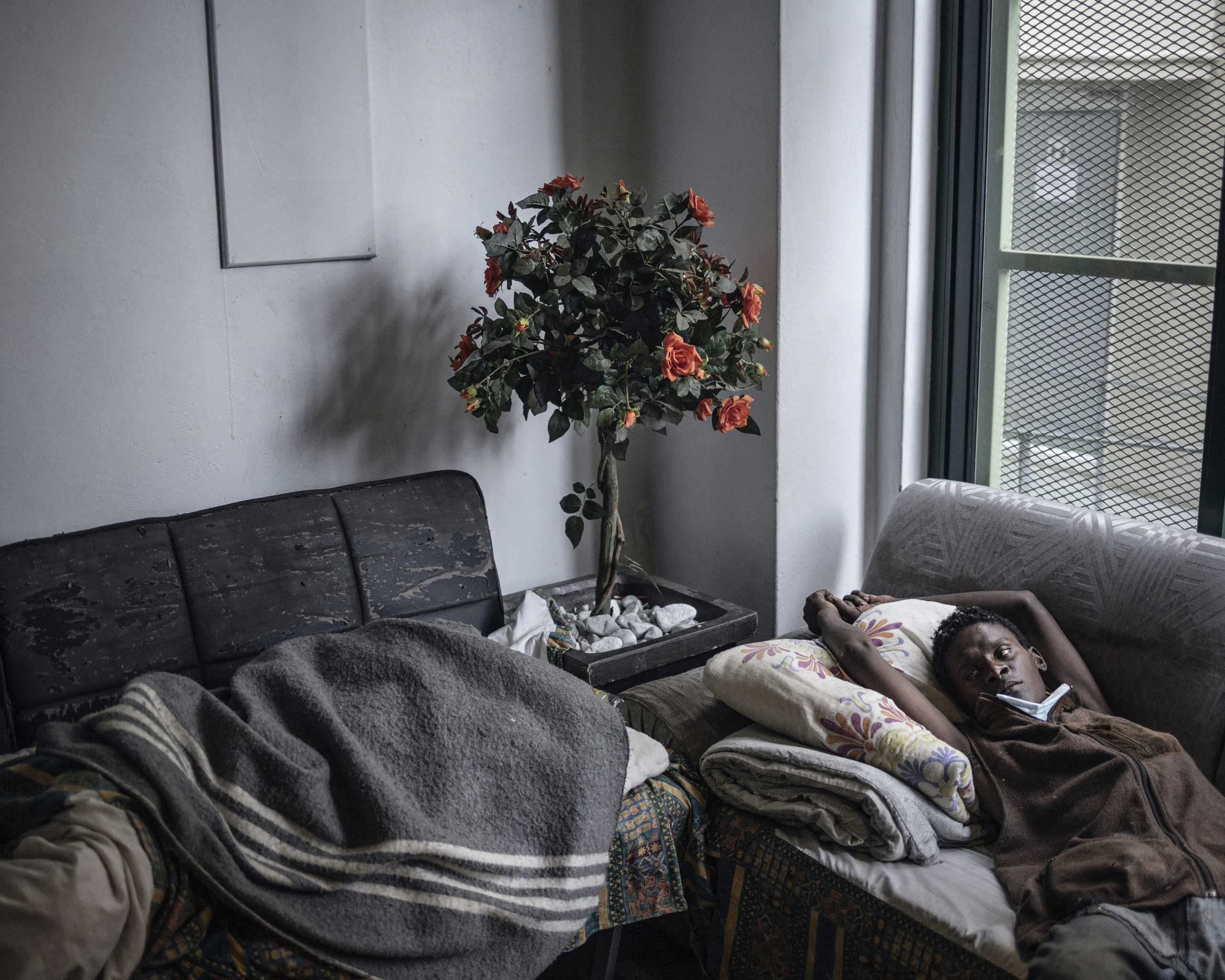
Justice, 26 years old and currently homeless, lays on a sofa at the displaced persons’ sub-unit – a shelter for the city’s homeless population – in Hillbrow, Johannesburg, South Africa on March 30, 2020, during the national lockdown imposed to stem the spread of the COVID-19 coronavirus. Many individuals choose the streets over shelters despite allegedly experiencing police brutality and increasingly colder weather. Doctors Without Borders assessed several temporary shelters for the destitute and homeless during the lockdown in South Africa, finding overcrowding and impossibility of physical distancing indoors, insufficient access to water and sanitation, lack of COVID-19 protocols, erratic distribution of food; placing occupants at increased risk of contracting COVID-19, tuberculosis and other infectious diseases. Though South Africa has a young population, and COVID-19 is deadlier among older people, there are millions who are vulnerable because of HIV or malnutrition.
[ngg src=”galleries” ids=”4″ display=”basic_thumbnail” thumbnail_width=”390″]
Rodrigo Abd – Naked Peru
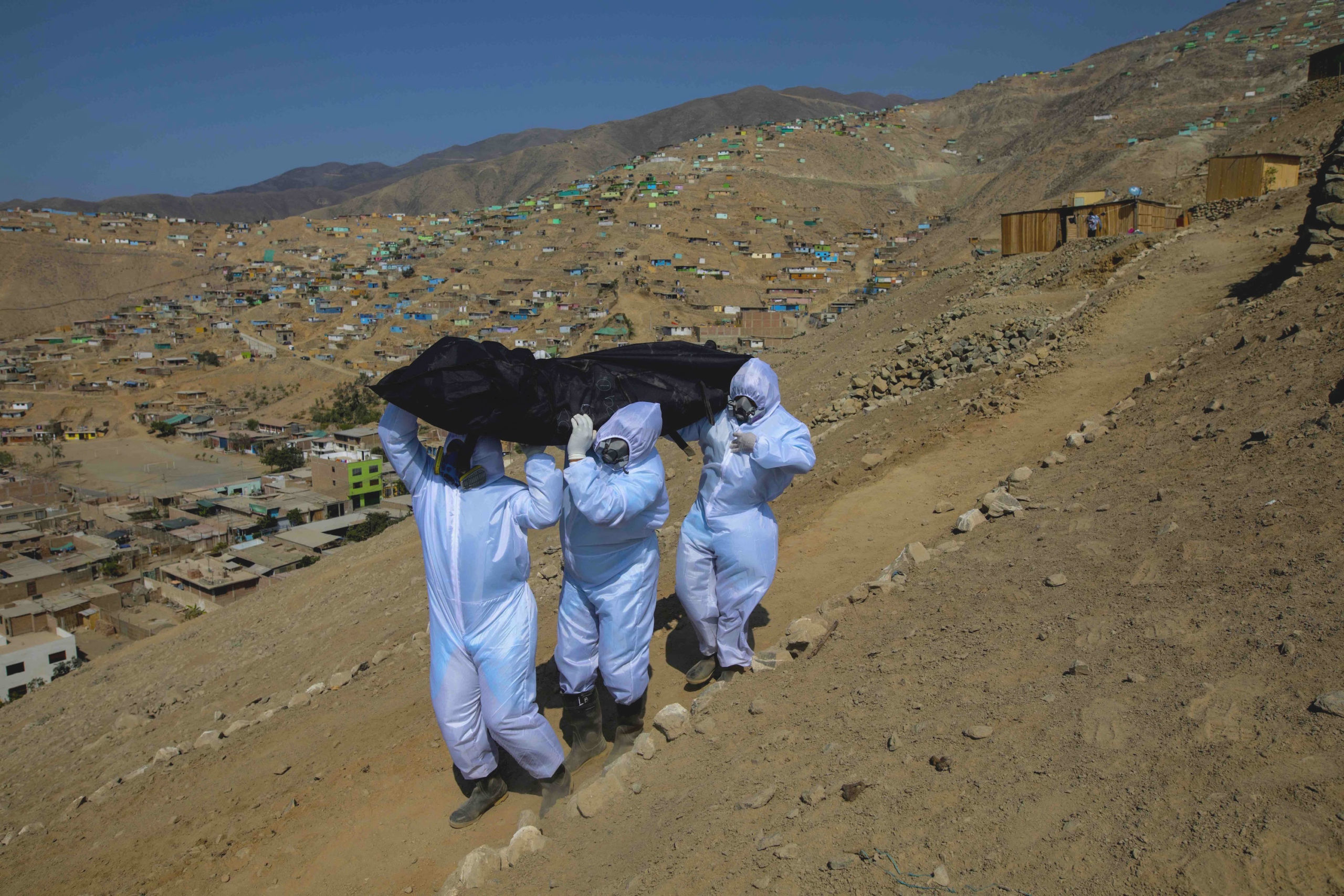
En esta foto del 8 de mayo de 2020, los trabajadores de la funeraria Piedrangel Luis Zerpa, Luis Brito, centro, y Jhoan Faneite, a la derecha, de Venezuela, llevan el cadáver al coche fúnebre de Marcos Espinoza, de 51 años, quien murió por coronavirus en Pachacamac, afueras de Lima, Perú. Marcos, soltero y sin hijos, era un humilde electricista, que había cambiado de oficio hace menos de una década después de trabajar 25 años como guardia de seguridad privada. Oscar Espinoza, de 50 años, y único hermano de Marcos, dijo que horas antes de morir Marcos lamentó que la peste lo hubiera alcanzado. “¿Por qué me afectó esta plaga, si no lastimé a nadie?”, Escuchó Oscar, que dormía en la habitación contigua.
Category: Covid-19 Photo Stories
Finalist
PROJECT DESCRIPTION
I have been covering the Pandemic situation mostly in Perú, between March 2020 and march 2021. Capturing the quiet moments amidst the wreckage of COVID-19, focusing on this “great” little stories that could really make us think as a society. Portraying the reality of the most vulnerable, those whom this Pandemic encountered unprotected and without resources to survive in the midst of chaos, those who are in constant crisis, those everyone sees but few know. I tried to tell the story of one of the worst outbreaks anywhere in the world. Peru has the highest per-capita COVID-19 mortality rate by ample measure – though the nation’s tragic tale is rarely frontpage news in most places. work is a testament to those many lives that would otherwise go unnoticed. Everything seems to have changed, although the reality is, that this Pandemic exposed the social problems that Peru was already experiencing in every sense. Deep pain, even more displaced people and uncertainty brings about this Pandemic, leaving a badly wounded and naked Peru.
AUTHOR BIOGRAPHY
Born in Bs. As., Argentina, on October 27, 1976. His career began as a staff photographer at La Razón and La Nación newspapers in Bs As, from 1999 to 2003. Since 2003, has been a staff photographer for the Associated Press based in Guatemala, with the exception of 2006, when he was based in Kabul, Afghanistan. Rodrigo has worked on AP special assignments covering the political turmoil in Bolivia in 2003 and Haiti in 2004. He also covered Venezuela’s presidential elections in 2007 / 2012 & the earthquake in Haiti in 2010. In 2010, has twice been embedded with US troops in Kandahar, Afghanistan. In 2011 he covered the political conflict in Lybia. In 2012 he covered the Syrian armed conflict. Abd, along with fellow AP photographers, M. Brabo, N. Contreras, K. Hamra, and Muhammed Muheisen, were awarded the 2013 Pulitzer Prize for Breaking News Photograph for their work covering the Syrian civil war. Over last years, he is working in several projects in Latinoamerica, looking for stories in what he call “LATINOAMERICA PROFUNDA”. Mixing his work between digital photography and his ancient WoodBox Camera. Actually based in Buenos Aires, Argentina.
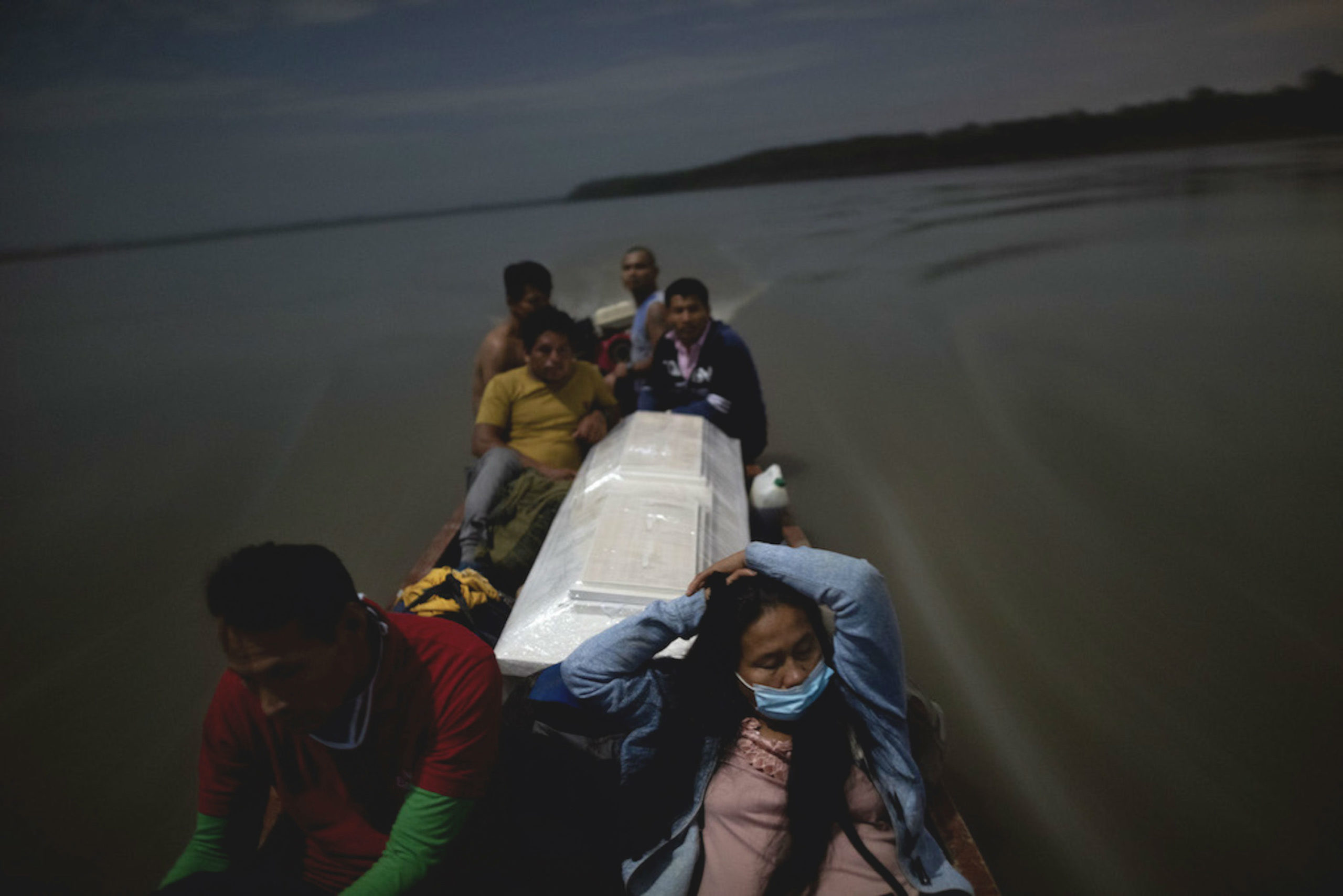
Relatives travel by boat along the Ucayali River while they transport the coffin with the body of Jose Barbaran, who died in the city of Pucallpa at 73 years of age due to COVID 19, Ucayali region, Peru, Tuesday, Sept. 29, 2020. Despite the risk, the family members decided to travel by night four hours in a boat without any light from the city of Pucallpa to the Palestinian village, where Jose Barbaran lived, in order to make the funeral and burial of their loved one. (Rodrigo Abd)
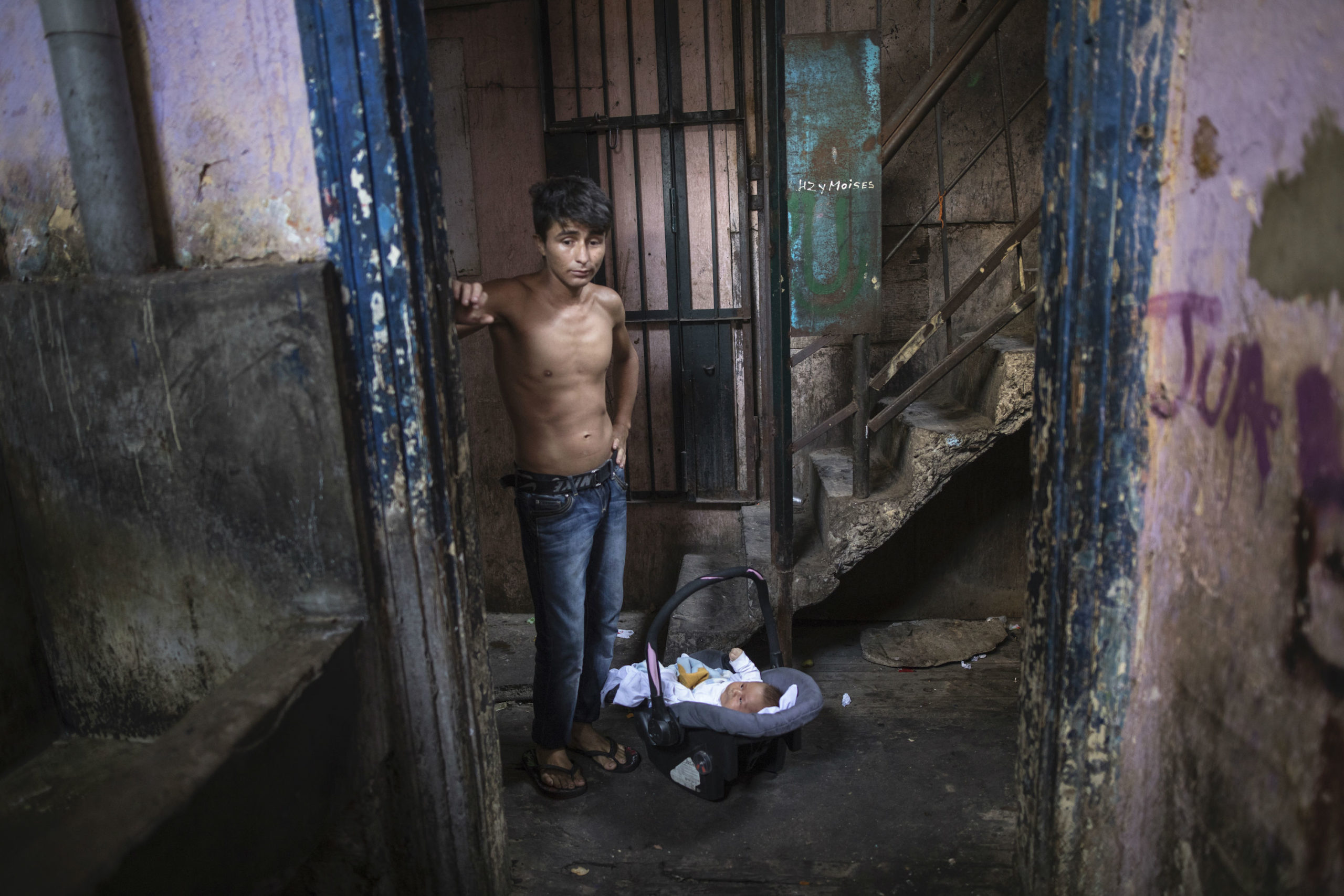
In this April 4, 2020 photo, Julio Morales, 26, stands next to his son Jose Alonso, 3 months old, in one of the common areas inside ’Luriganchito”building during the emergency delacred by the government, in Lima, Peru. (AP Photo/Rodrigo Abd)
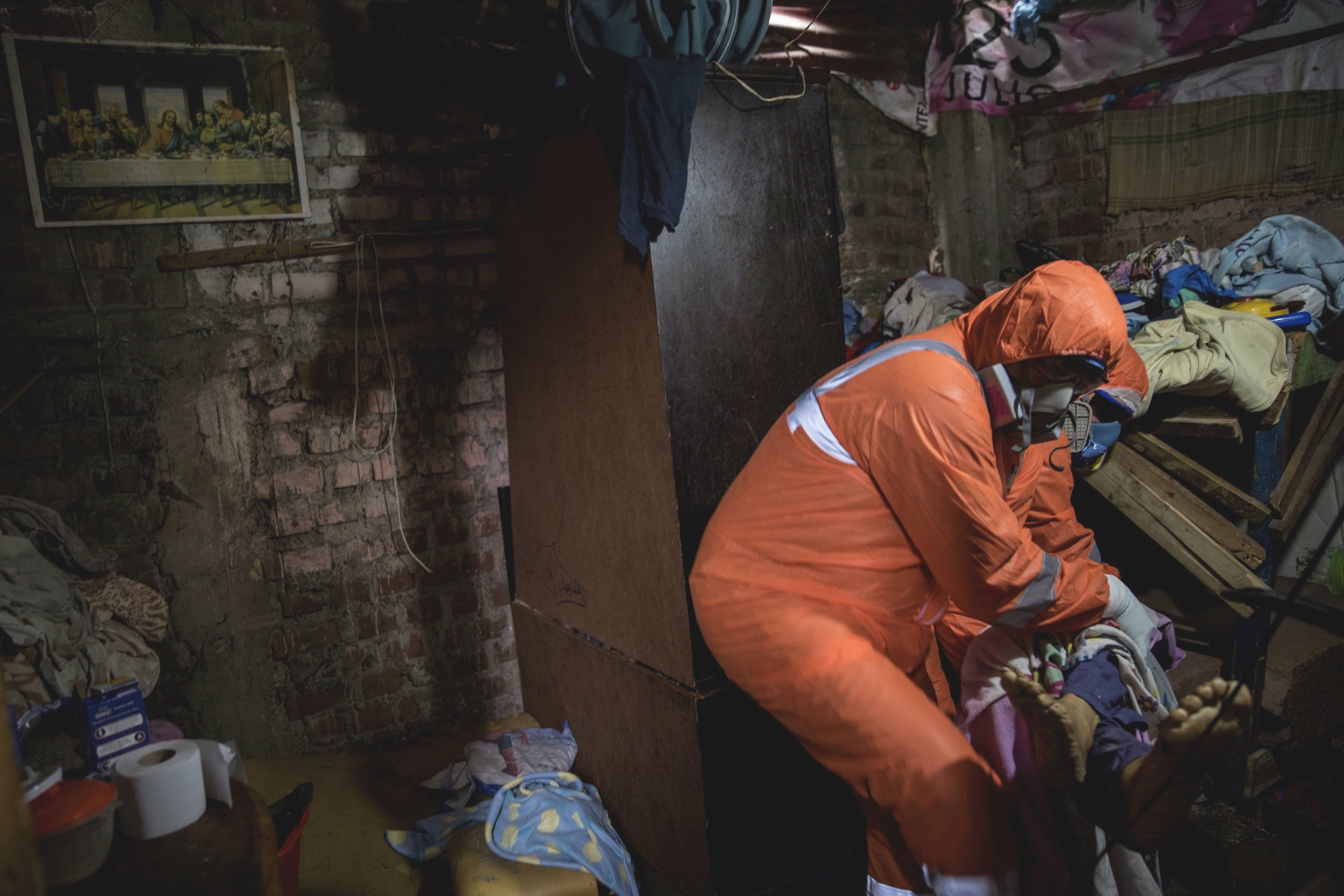
In this May 4, 2020 photo, funeral workers Jhoan Faneite, Luis Brito, 28, from Venezuela, removes the body of Carlos Estrada, 85, a retired carpenter who suffered from Parkinson’s disease and who died at his home in Chorrillos, after presenting breathing difficulties, headaches and diarrhea, the main symptoms of COVID -19.Luis Brito, 28, from Venezuela, COVID-19. (AP Photo/Rodrigo Abd)
[ngg src=”galleries” ids=”5″ display=”basic_thumbnail” thumbnail_width=”390″]
Yan Boechat – Death in the Amazon
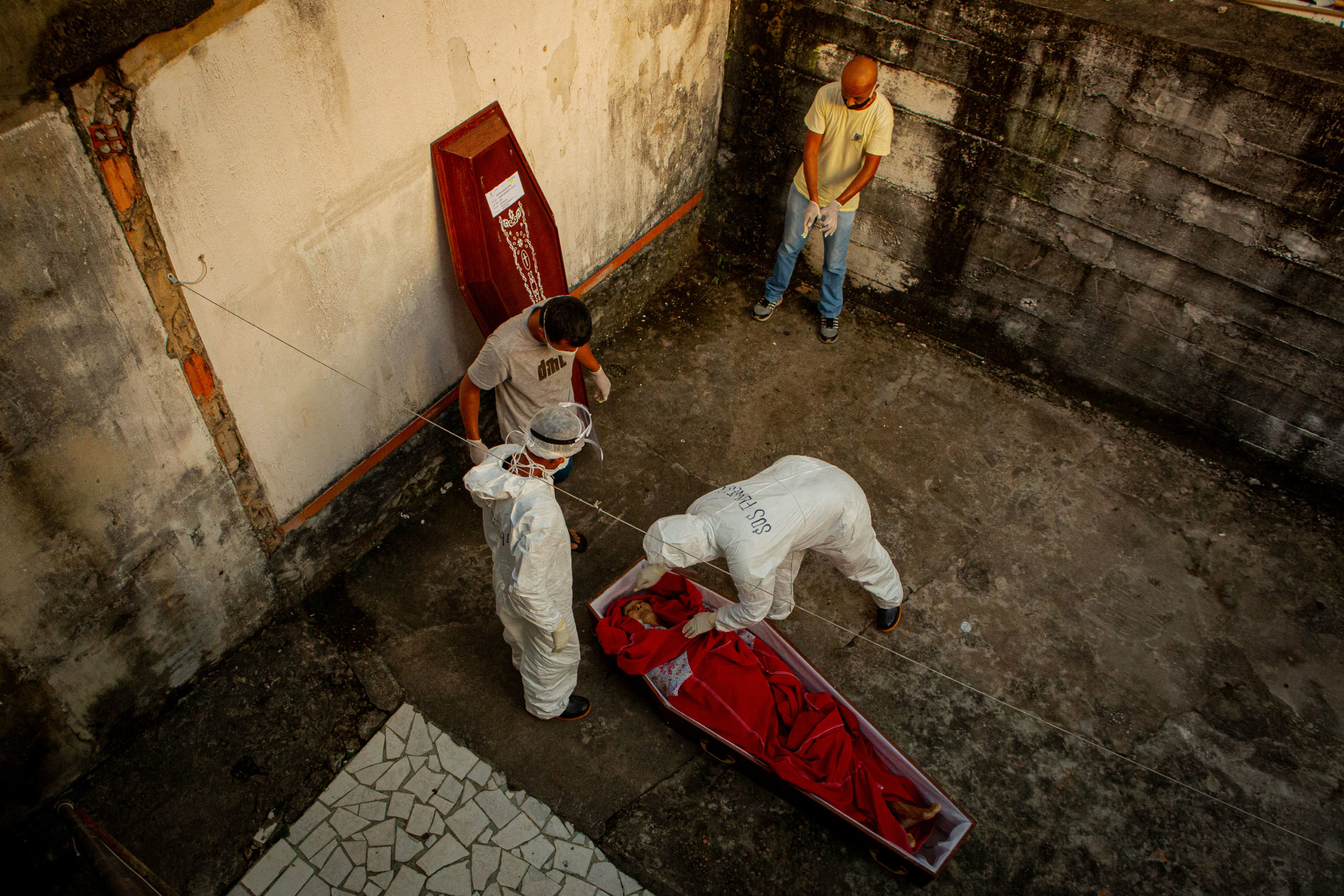
The body of Rubens Nogueira Batista, 77, receives the last care before being taken to the cold room of the funeral service in Manaus. He died at home with Covid-19 symptoms and did not want to go to hospitals for fear of being infected by the new coronavirus.
PROJECT DESCRIPTION
Manaus, a metropolis of more than two million inhabitants in the middle of the Amazon Rainforest, suffered the lethal impacts of the COVID 19 pandemic like no other Brazilian City. Hospitals without respirators, ambulances without oxygen, mass graves. Manaus succumbed to the new coronavirus quickly and brutally. Fear took over this city founded by the Portuguese at the end of the 17th century. Terrified by the stories of suffering and lonely deaths, many people adopted a negative attitude towards the disease. Even with the clear symptoms of Covid-19, they refused to seek medical help. The number of people dying in their homes quickly exploded. These photos tell this story. The history of Brazilians who lost their lives due, many times, to the State’s inability to provide the most basic care in a time of crisis. These are stories of poor people, victims of the incredible inequality that marks this country.
AUTHOR BIOGRAPHY
Yan Boechat has been a journalist for over 20 years. Throughout most of his career, he worked as a writer-reporter, writing for the largest publications in Brazil, both in daily newspapers, magazines, and news sites. He is or was a collaborator also in international vehicles, such as The New York Times, BBC, Deutsche Welle, Voice of America, NBC News, among others. In the last decade he started to act more and more independently and, throughout his travels to different parts of the world, he integrated photography, an old passion, into his writing work. Today he divides his time between writing, photography, and video. Yan Boechat has dedicated his work to cover human impacts caused by major events, such as wars, environmental disasters, urban conflicts, inequality, and violence. Over the years, he has covered humanitarian issues in countries such as Syria, Iraq, Lebanon, Turkey, Iran, Afghanistan, Palestine, Ukraine, Congo, DRC, Angola, Egypt, Tunisia, Colombia, Venezuela, and in different parts of Brazil. Today he is based in São Paulo (Brazil) and in the last year he has focused his attention on issues related to immense inequality and violence in his native country.
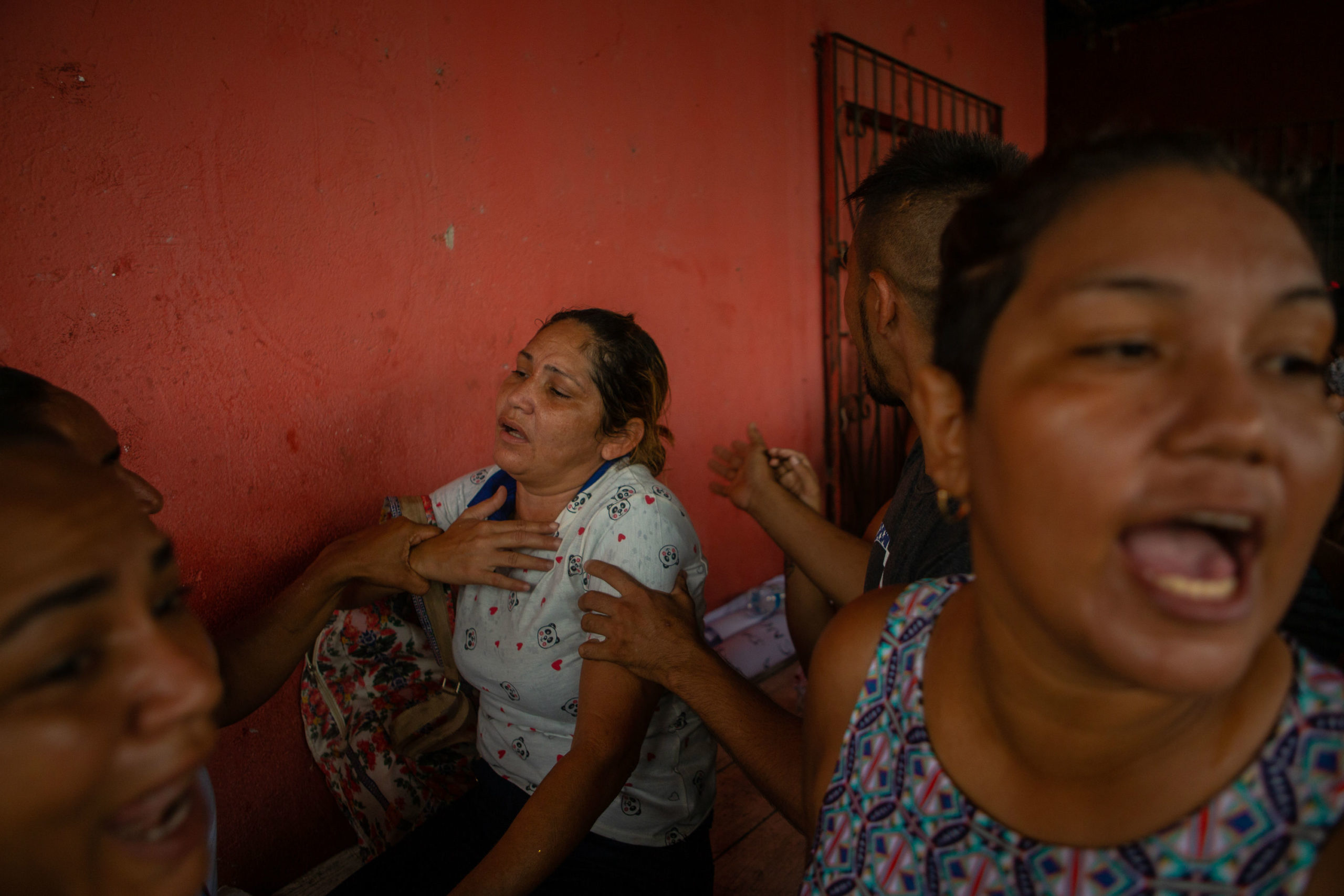
Relative of inmates of the Manaus Prison recover from passing out after the police invaded the prison to stop a riot. The inmates were complaining that the Covid-19 patients were not receiving treatment inside the prison and there was no isolation for them
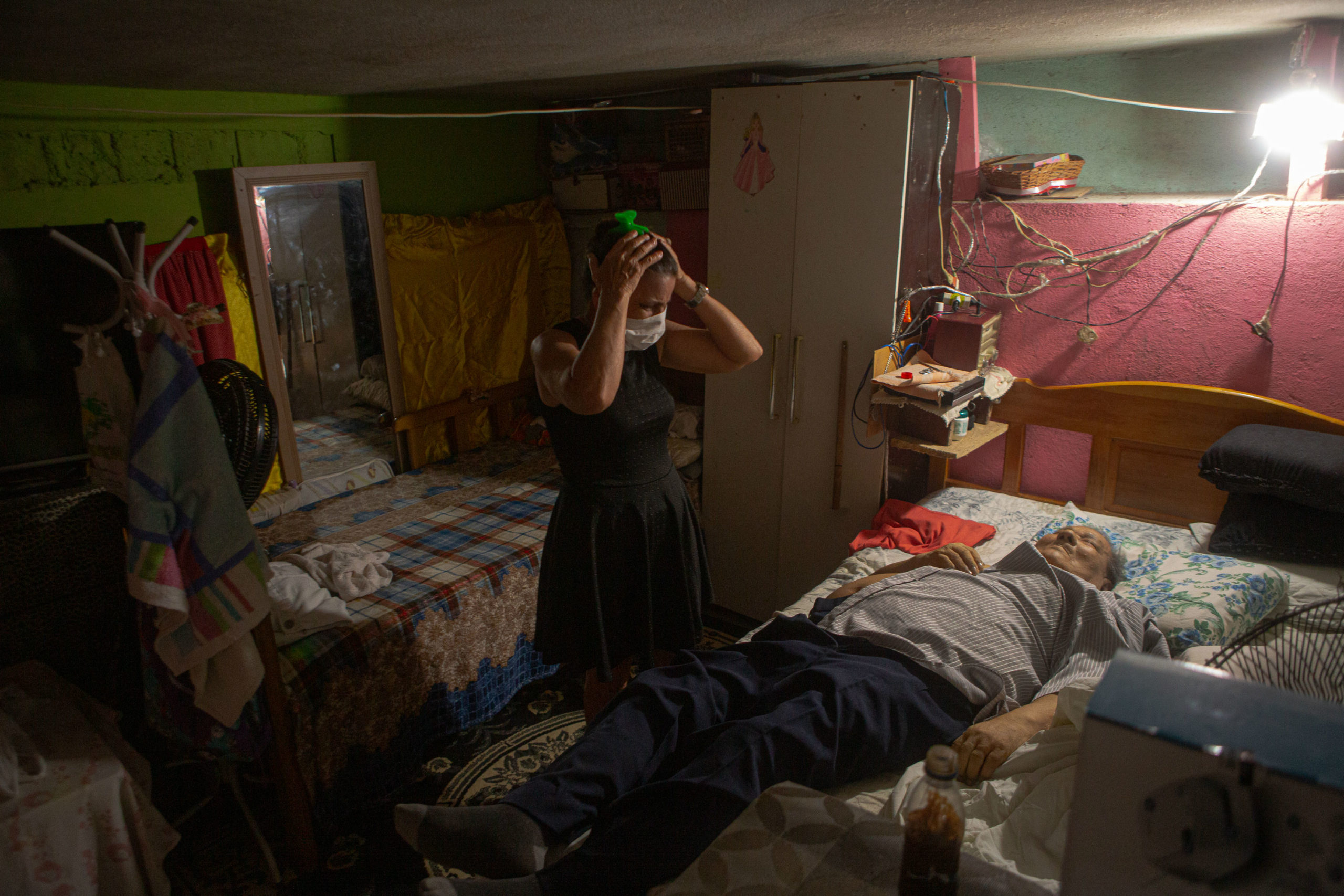
A woman observes the body of his father lying down on his bed moments after he died with problems to breath. The man had all the symptoms of Covid 19 but refused to look for assistance in a local hospital
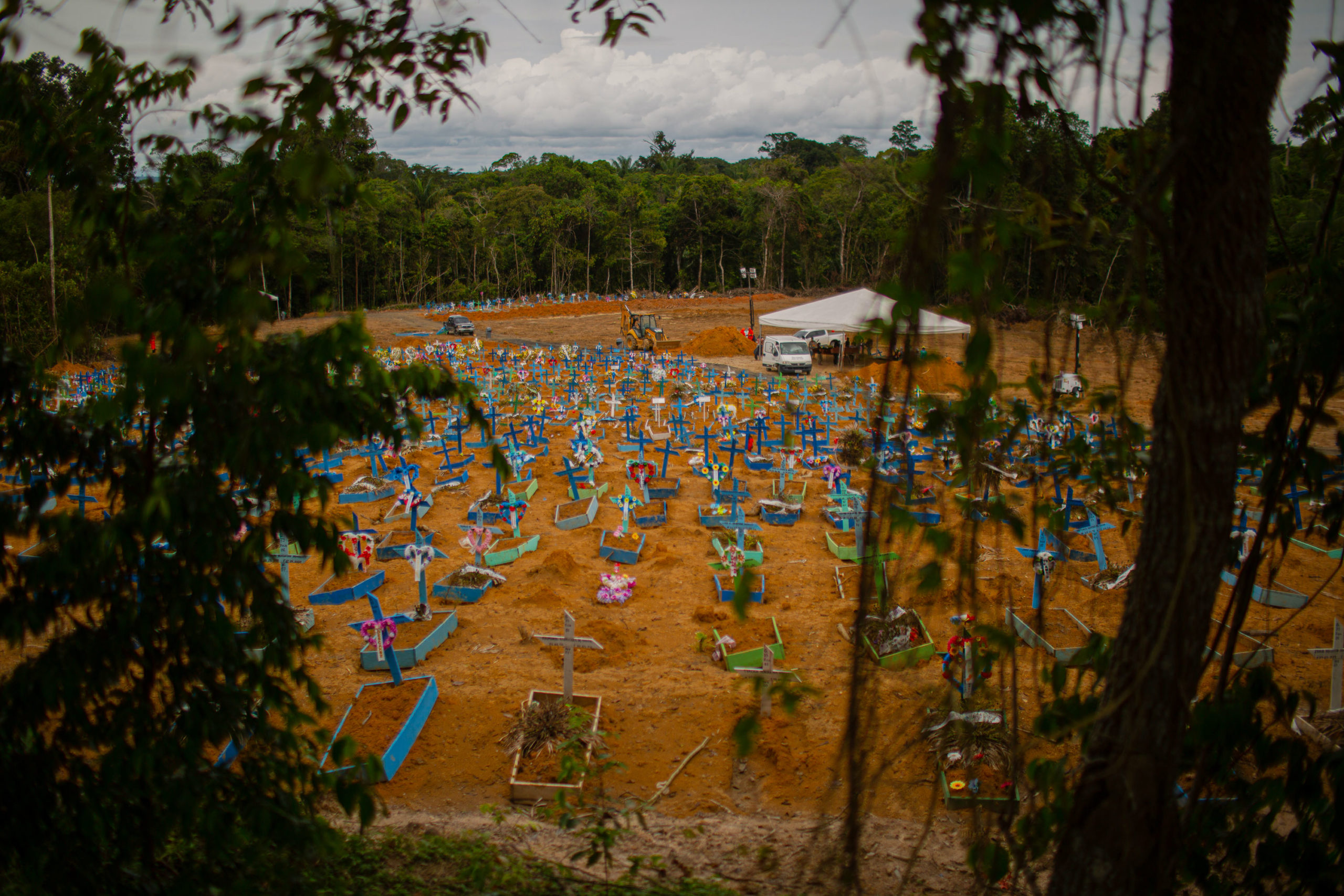
The Tarumã Cemetery received most of the victims of Covid 19 in Manaus. During the peak days the number of burials jumped from 25 a day to 150 a day. Mass graves were opened
[ngg src=”galleries” ids=”6″ display=”basic_thumbnail” thumbnail_width=”390″]






